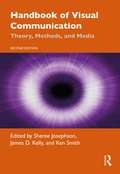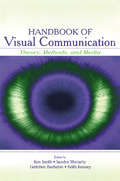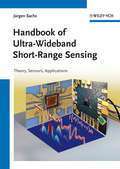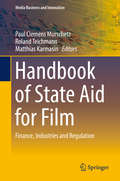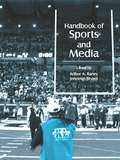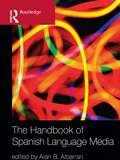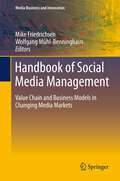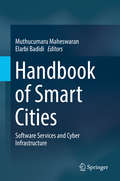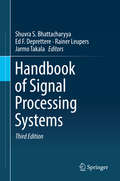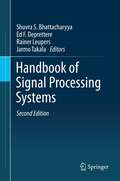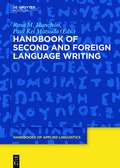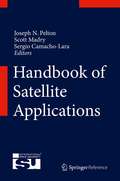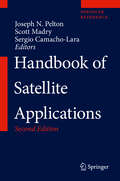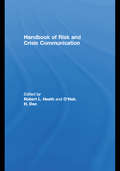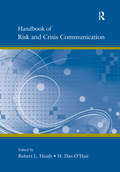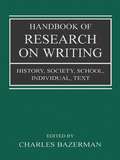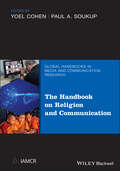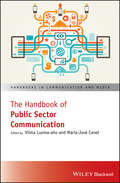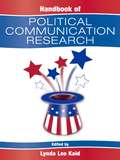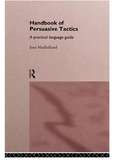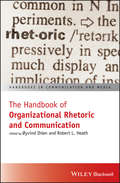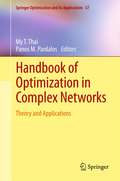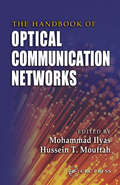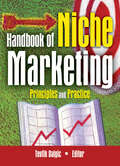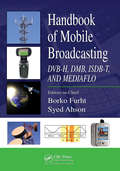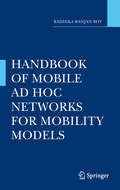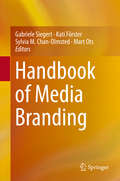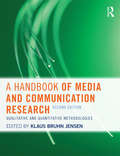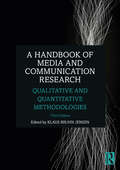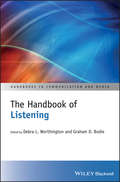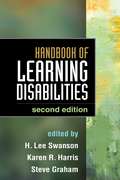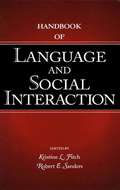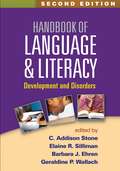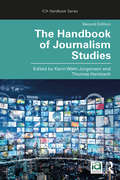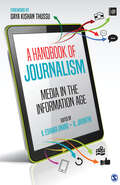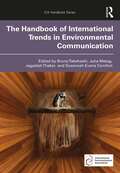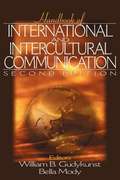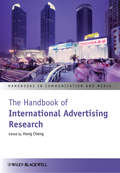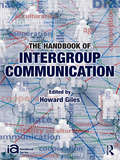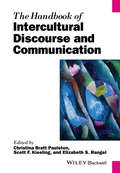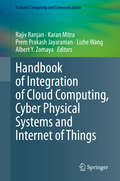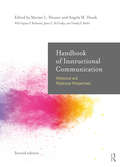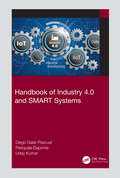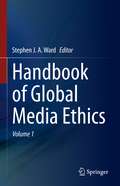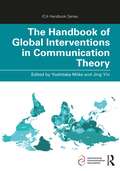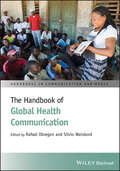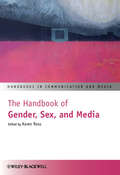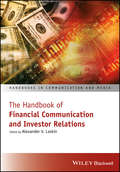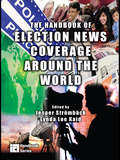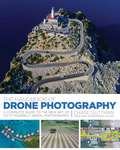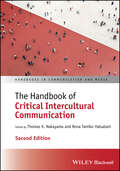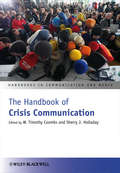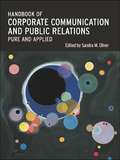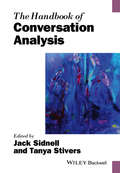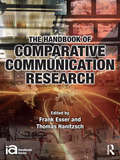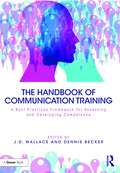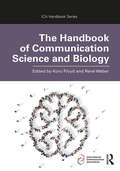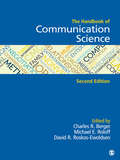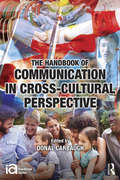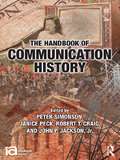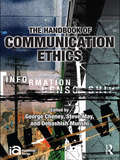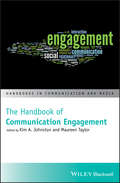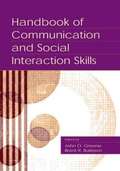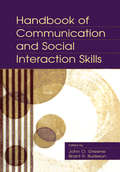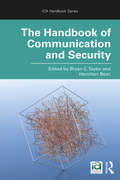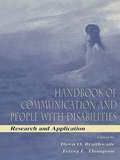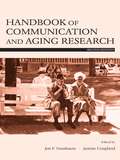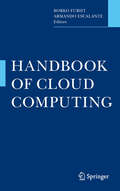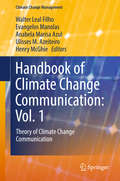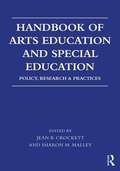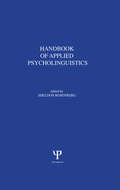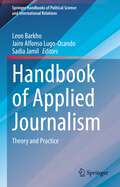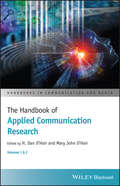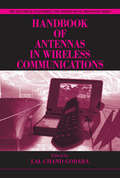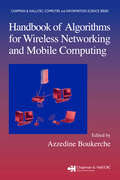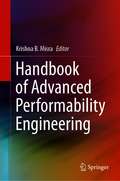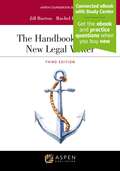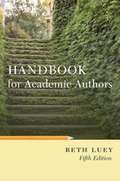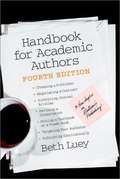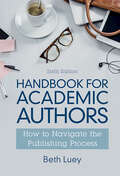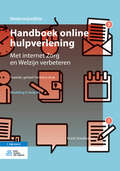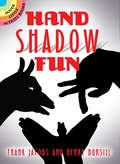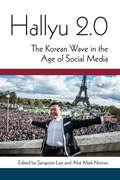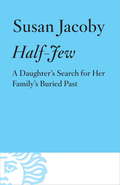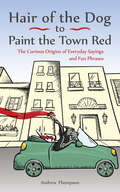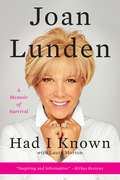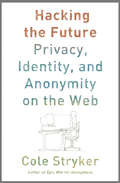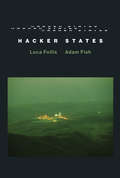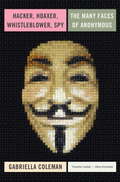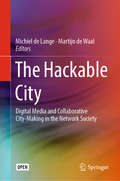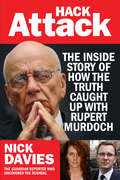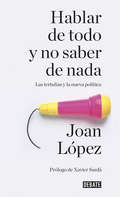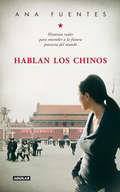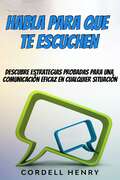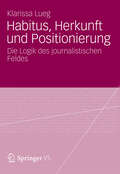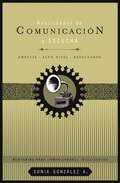- Table View
- List View
Handbook of Visual Communication: Theory, Methods, and Media (Routledge Communication Series)
by Sheree Josephson James D. Kelly Ken SmithThis Handbook of Visual Communication explores the key theoretical areas and research methods of visual communication. With chapters contributed by many of the best-known and respected scholars in visual communication, this volume brings together significant and influential work in the discipline. The second edition of this already-classic text has been completely revised to reflect the metamorphosis of communication in the last fifteen years and the ubiquity of visual communication in our modern mediated lifestyle. Thirteen major theories of communication are defined by the top experts in their fields: perception, cognition, aesthetics, visual rhetoric, semiotics, cultural studies, ethnography, narrative, media aesthetics, digital media, intertextuality, ethics, and visual literacy. Each of these theory chapters is followed by an exemplar study or two in the area, demonstrating the various methods used in visual communication research as well as the research approaches applicable for specific media types. The Handbook serves as an invaluable reference for visual communication theory as well as a useful resource book of research methods in the discipline. It defines the current state of theory and research in visual communication and serves as a foundation for future scholarship and study. The Handbook of Visual Communication is a theoretical and methodological handbook for visual communication researchers and a compilation for much of the theoretical background necessary to understand visual communication. It is required reading for scholars, researchers, and advanced students in visual communication, and it will be influential in other disciplines such as advertising, persuasion, and media studies. The volume will also be essential to media practitioners seeking to understand the visual aspects of how audiences use media to contribute to more effective use of each specific medium.
Handbook of Visual Communication: Theory, Methods, and Media (Lea’s Communication Series)
by Kenneth L. Smith Sandra Moriarty Keith Kenney Gretchen BarbatsisThis Handbook of Visual Communication explores the key theoretical areas in visual communication, and presents the research methods utilized in exploring how people see and how visual communication occurs. With chapters contributed by many of the best-known and respected scholars in visual communication, this volume brings together significant and influential work in the visual communication discipline.The theory chapters included here define the twelve major theories in visual communication scholarship: aesthetics, perception, representation, visual rhetoric, cognition, semiotics, reception theory, narrative, media aesthetics, ethics, visual literacy, and cultural studies. Each of these theory chapters is followed by exemplar studies in the area, demonstrating the various methods used in visual communication research as well as the research approaches applicable for specific media types.The Handbook serves as an invaluable reference for visual communication theory as well as a useful resource book of research methods in the discipline. It defines the current state of theory and research in visual communication, and serves as a foundation for future scholarship and study. As such, it is required reading for scholars, researchers, and advanced students in visual communication, and it will be influential in other disciplines in which the visual component is key, including advertising, persuasion, and media studies. The volume will also be useful to practitioners seeking to understand the visual aspects of their media and the visual processes used by their audiences.
Handbook of Ultra-Wideband Short-Range Sensing
by Jürgen SachsRanging from the theoretical basis of UWB sensors via implementation issues to applications, this much-needed book bridges the gap between designers and appliers working in civil engineering, biotechnology, medical engineering, robotic, mechanical engineering, safety and homeland security.From the contents:* History* Signal and systems in time and frequency domain* Propagation of electromagnetic waves (in frequency and time domain)* UWB-Principles* UWB-antennas and applicators* Data processing* Applications
Handbook of State Aid for Film: Finance, Industries And Regulation (Media Business and Innovation Ser.)
by Paul Clemens Murschetz Roland Teichmann Matthias KarmasinThis book is an analysis of the specificities of public film funding on an international scale. It shows how public funding schemes add value to film-making and other audio-visual productions and provides a comprehensive analysis of today’s global challenges in the film industry such as industry change, digital transformation, and shifting audience tastes. Based on insights from fields such as cultural economics, media economics, media management and media governance studies, the authors illustrate how public spending shapes the financial fitness of national and international film industries. This highly informative book will help both scholars and practitioners in the film industry to understand the complexity of issues and the requirements necessary to preserve the social benefits of film as an important cultural good.
Handbook of Sports and Media (Routledge Communication Series)
by Jennings Bryant Arthur A. RaneyThis distinctive Handbook covers the breadth of sports and media scholarship, one of the up-and-coming topics bridging media entertainment, sports management, and popular culture. Organized into historical, institutional, spectator, and critical studies perspectives, this volume brings together the work of many researchers into one quintessential volume, defining the full scope of the subject area. Editors Arthur Raney and Jennings Bryant have recruited contributors from around the world to identify and synthesize the research representing numerous facets of the sports-media relationship. As a unique collection on a very timely topic, the volume offers chapters examining the development of sports media; production, coverage, and economics of sports media; sports media audiences; sports promotion; and race and gender issues in sports and media. Unique in its orientation and breadth, the Handbook of Sports and Media is destined to play a major role in the future development of this fast-growing area of study. It is a must-have work for scholars, researchers, and graduate students working in media entertainment, media psychology, mass media/mass communication, sports marketing and management, popular communication, popular culture, and cultural studies.
The Handbook of Spanish Language Media
by Alan AlbarranWith the rise of Spanish language media around the world, The Handbook of Spanish Language Media provides an overview of the field and its emerging issues. This Handbook will serve as the definitive source for scholars interested in this emerging field of study; not only to provide background knowledge of the various issues and topics relevant to Spanish language media, but also to establish directions for future research in this rapidly growing area. This volume draws on the expertise of authors and collaborators across the globe. The book is an essential reference work for graduate students, scholars, and media practitioners interested in Spanish language media, and is certain to influence the course of future research in this growing and increasingly influential area.
Handbook of Social Media Management: Value Chain and Business Models in Changing Media Markets
by Mike Friedrichsen Wolfgang Mühl-BenninghausDigitization and Web 2.0 have brought about continuous change from traditional media management to new strategic, operative and normative management options. Social media management is on the agenda of every media company, and requires a new set of specialized expertise on digital products and communication. At the same time, social media has become a vibrant field of research for media economists and media management researchers. In this handbook, international experts present a comprehensive account of the latest developments in social media research and management, consistently linking classical media management with social media. The articles discuss new theoretical approaches as well as empirical findings and applications, yielding an interesting overview of interdisciplinary and international approaches. The book's main sections address forms and content of social media; impact and users; management with social media; and a new value chain with social media. The book will serve as a valuable reference work for researchers, students and professionals working in media and public relations.
Handbook of Smart Cities: Software Services and Cyber Infrastructure
by Muthucumaru Maheswaran Elarbi BadidiThis handbook provides a glimpse of the research that is underway in smart cities, with an examination of the relevant issues. It describes software infrastructures for smart cities, the role of 5G and Internet of things in future smart cities scenarios, the use of clouds and sensor-based devices for monitoring and managing smart city facilities, a variety of issues in the emerging field of urban informatics, and various smart city applications. Handbook of Smart Cities includes fifteen chapters from renowned worldwide researchers working on various aspects of smart city scale cyber-physical systems. It is intended for researchers, developers of smart city technologies and advanced-level students in the fields of communication systems, computer science, and data science. This handbook is also designed for anyone wishing to find out more about the on-going research thrusts and deployment experiences in smart cities. It is meant to provide a snapshot of the state-of-the-art at the time of its writing in several software services and cyber infrastructures as pertinent to smart cities. This handbook presents application case studies in video surveillance, smart parking, and smart building management in the smart city context. Unique experiences in designing and implementing the applications or the issues involved in developing smart city level applications are described in these chapters. Integration of machine learning into several smart city application scenarios is also examined in some chapters of this handbook.
Handbook of Signal Processing Systems
by Shuvra S. Bhattacharyya Ed F. Deprettere Rainer Leupers Jarmo TakalaIn this new edition of the Handbook of Signal Processing Systems, many of the chapters from the previous editions have been updated, and several new chapters have been added. The new contributions include chapters on signal processing methods for light field displays, throughput analysis of dataflow graphs, modeling for reconfigurable signal processing systems, fast Fourier transform architectures, deep neural networks, programmable architectures for histogram of oriented gradients processing, high dynamic range video coding, system-on-chip architectures for data analytics, analysis of finite word-length effects in fixed-point systems, and models of architecture. There are more than 700 tables and illustrations; in this edition over 300 are in color. This new edition of the handbook is organized in three parts. Part I motivates representative applications that drive and apply state-of-the art methods for design and implementation of signal processing systems; Part II discusses architectures for implementing these applications; and Part III focuses on compilers, as well as models of computation and their associated design tools and methodologies.
Handbook of Signal Processing Systems
by Ed F. Deprettere Jarmo Takala Rainer Leupers Shuvra S. BhattacharyyaHandbook of Signal Processing Systems is organized in three parts. The first part motivates representative applications that drive and apply state-of-the art methods for design and implementation of signal processing systems; the second part discusses architectures for implementing these applications; the third part focuses on compilers and simulation tools, describes models of computation and their associated design tools and methodologies. This handbook is an essential tool for professionals in many fields and researchers of all levels.
Handbook of Second and Foreign Language Writing (Handbooks Of Applied Linguistics #11)
by Rosa M. Manchón Paul Kei MatsudaThe Handbook of Second and Foreign Language Writing is an authoritative reference compendium of the theory and research on second and foreign language writing that can be of value to researchers, professionals, and graduate students. It is intended both as a retrospective critical reflection that can situate research on L2 writing in its historical context and provide a state of the art view of past achievements, and as a prospective critical analysis of what lies ahead in terms of theory, research, and applications. Accordingly, the Handbook aims to provide (i) foundational information on the emergence and subsequent evolution of the field, (ii) state-of-the-art surveys of available theoretical and research (basic and applied) insights, (iii) overviews of research methods in L2 writing research, (iv) critical reflections on future developments, and (iv) explorations of existing and emerging disciplinary interfaces with other fields of inquiry.
Handbook of Satellite Applications
by Sergio Camacho-Lara Scott Madry Joseph N. PeltonTop space experts from around the world have collaborated to produce this comprehensive, authoritative, and clearly illustrated reference guide to the fast growing, multi-billion dollar field of satellite applications and space communications. This handbook, done under the auspices of the International Space University based in France, addresses not only system technologies but also examines market dynamics, technical standards and regulatory constraints. The handbook is a completely multi-disciplinary reference book that covers, in an in-depth fashion, the fields of satellite telecommunications, Earth observation, remote sensing, satellite navigation, geographical information systems, and geosynchronous meteorological systems. It covers current practices and designs as well as advanced concepts and future systems. It provides a comparative analysis of the common technologies and design elements for satellite application bus structures, thermal controls, power systems, stabilization techniques, telemetry, command and control (TTC), and orbital configurations. These common aspects are addressed in an integrated fashion to explain how all these space systems share similar design features, but also have quite specialized application packages to carry out their various missions. No other reference in print today provides such a comprehensive and in-depth guide to all forms of application satellites, including small sats as used by countries just beginning space application programs.
Handbook of Satellite Applications
by Joseph N. Pelton Scott Madry Sergio Camacho-LaraTop space experts from around the world have collaborated to produce this comprehensive, authoritative, and clearly illustrated reference guide to the fast growing, multi-billion dollar field of satellite applications and space communications. This handbook, done under the auspices of the International Space University based in France, addresses not only system technologies but also examines market dynamics, technical standards and regulatory constraints. The handbook is a completely multi-disciplinary reference book that covers, in an in-depth fashion, the fields of satellite telecommunications, Earth observation, remote sensing, satellite navigation, geographical information systems, and geosynchronous meteorological systems. It covers current practices and designs as well as advanced concepts and future systems. It provides a comparative analysis of the common technologies and design elements for satellite application bus structures, thermal controls, power systems, stabilization techniques, telemetry, command and control (TTC), and orbital configurations. These common aspects are addressed in an integrated fashion to explain how all these space systems share similar design features, but also have quite specialized application packages to carry out their various missions. No other reference in print today provides such a comprehensive and in-depth guide to all forms of application satellites, including small sats as used by countries just beginning space application programs.
Handbook of Risk and Crisis Communication (Routledge Communication Ser.)
by H. Dan O'Hair Robert L. HeathThe Handbook of Risk and Crisis Communication explores the scope and purpose of risk, and its counterpart, crisis, to facilitate the understanding of these issues from conceptual and strategic perspectives. Recognizing that risk is a central feature of our daily lives, found in relationships, organizations, governments, the environment, and a wide variety of interactions, contributors to this volume explore such questions as: "What is likely to happen, to whom, and with what consequences?"; "To what extent can science and vigilance prevent or mitigate negative outcomes?"; and "What obligation do some segments of local, national, and global populations have to help other segments manage risks?", shedding light on the issues in the quest for definitive answers. The Handbook offers a broad approach to the study of risk and crisis as joint concerns. Chapters explore the reach of crisis and risk communication, define and examine key constructs, and parse the contexts of these vital areas. As a whole, the volume presents a comprehensive array of studies that highlight the standard principles and theories on both topics, serving as the largest effort to date focused on engaging risk communication discussions in a comprehensive manner. With perspectives from psychology, sociology, anthropology, political science, economics, and communication, the Handbook of Risk and Crisis Communication enlarges the approach to defining and recognizing risk and how should it best be managed. It provides vital insights for all disciplines studying risk, including communication, public relations, business, and psychology, and will be required reading for scholars and researchers investigating risk and crisis in various contexts.
Handbook of Risk and Crisis Communication (Routledge Communication Series)
by Robert L. Heath; H. Dan O’HairThe Handbook of Risk and Crisis Communication explores the scope and purpose of risk, and its counterpart, crisis, to facilitate the understanding of these issues from conceptual and strategic perspectives. Recognizing that risk is a central feature of our daily lives, found in relationships, organizations, governments, the environment, and a wide variety of interactions, contributors to this volume explore such questions as "What is likely to happen, to whom, and with what consequences?" "To what extent can science and vigilance prevent or mitigate negative outcomes?" and "What obligation do some segments of local, national, and global populations have to help other segments manage risks?", shedding light on the issues in the quest for definitive answers.The Handbook offers a broad approach to the study of risk and crisis as joint concerns. Chapters explore the reach of crisis and risk communication, define and examine key constructs, and parse the contexts of these vital areas. As a whole, the volume presents a comprehensive array of studies that highlight the standard principles and theories on both topics, serving as the largest effort to date focused on engaging risk communication discussions in a comprehensive manner. Now available in paperback, the Handbook of Risk and Crisis Communication can be readily used in graduate coursework and individual research programs. With perspectives from psychology, sociology, anthropology, political science, economics, and communication, the Handbook provides vital insights for all disciplines studying risk, and is required reading for scholars and researchers investigating risk and crisis in various contexts.
Handbook of Research on Writing: History, Society, School, Individual, Text
by Charles BazermanThe Handbook of Research on Writing ventures to sum up inquiry over the last few decades on what we know about writing and the many ways we know it: How do people write? How do they learn to write and develop as writers? Under what conditions and for what purposes do people write? What resources and technologies do we use to write? How did our current forms and practices of writing emerge within social history? What impacts has writing had on society and the individual? What does it mean to be and to learn to be an active participant in contemporary systems of meaning? This cornerstone volume advances the field by aggregating the broad-ranging, interdisciplinary, multidimensional strands of writing research and bringing them together into a common intellectual space. Endeavoring to synthesize what has been learned about writing in all nations in recent decades, it reflects a wide scope of international research activity, with attention to writing at all levels of schooling and in all life situations. Chapter authors, all eminent researchers, come from disciplines as diverse as anthropology, archeology, typography, communication studies, linguistics, journalism, sociology, rhetoric, composition, law, medicine, education, history, and literacy studies. The Handbook’s 37 chapters are organized in five sections:*The History of Writing;*Writing in Society;*Writing in Schooling;*Writing and the Individual; *Writing as Text This volume, in summing up what is known about writing, deepens our experience and appreciation of writing—in ways that will make teachers better at teaching writing and all of its readers better as individual writers. It will be interesting and useful to scholars and researchers of writing, to anyone who teaches writing in any context at any level, and to all those who are just curious about writing.
The Handbook of Religion and Communication (Global Handbooks in Media and Communication Research)
by Yoel Cohen Paul A. SoukupProvides a contemporary view of the intertwined relationship of communication and religion The Handbook on Religion and Communication presents a detailed investigation of the complex interaction between media and religion, offering diverse perspectives on how both traditional and new media sources continue to impact religious belief and practice across multiple faiths around the globe. Contributions from leading international scholars address key themes such as the changing role of religious authority in the digital age, the role of media in cultural shifts away from religious institutions, and the ways modern technologies have transformed how religion is communicated and portrayed. Divided into five parts, the Handbook opens with a state-of-the-art overview of the subject’s intellectual landscape, introducing the historical background, theoretical foundations, and major academic approaches to communication, media, and religion. Subsequent sections focus on institutional and functional perspectives, theological and cultural approaches, and new approaches in digital technologies. The essays provide insight into a wide range of topics, including religious use of media, religious identity, audience gratification, religious broadcasting, religious content in entertainment, films and religion, news reporting about religion, race and gender, the sex-religion matrix, religious crisis communication, public relations and advertising, televangelism, pastoral ministry, death and the media, online religion, future directions in religious communication, and more. Explores the increasing role of media in creating religious identity and communicating religious experience Discusses the development and evolution of the communication practices of various religious bodies Covers all major media sources including radio, television, film, press, digital online content, and social media platforms Presents key empirical research, real-world case studies, and illustrative examples throughout Encompasses a variety of perspectives, including individual and institutional actors, academic and theoretical areas, and different forms of communication media Explores media and religion in Judeo-Christian traditions, Islam, Buddhism, Hinduism, religions of Africa, Atheism, and others The Handbook on Religion and Communication is an essential resource for scholars, academic researchers, practical theologians, seminarians, mass communication researchers, and undergraduate and graduate students taking courses on media and religion.
The Handbook of Public Sector Communication (Handbooks in Communication and Media #91)
by Vilma Luoma-Aho María‐José CanelA multidisciplinary collection on global public entity strategic communication Research into public sector communication investigates the interaction between public and governmental entities and citizens within their sphere of influence. Today’s public sector organizations are operating in environments where people receive their information from multiple sources. Although modern research demonstrates the immense impact public entities have on democracy and societal welfare, communication in this context is often overlooked. Public sector organizations need to develop “communicative intelligence” in balancing their institutional agendas and aims of public engagement. The Handbook of Public Sector Communication is the first comprehensive volume to explore the field. This timely, innovative volume examines the societal role, environment, goals, practices, and development of public sector strategic communication. International in scope, this handbook describes and analyzes the contexts, policies, issues, and questions that shape public sector communication. An interdisciplinary team of leading experts discusses diverse subjects of rising importance to public sector, government, and political communication. Topics include social exchange relationships, crisis communication, citizen expectations, measuring and evaluating media, diversity and inclusion, and more. Providing current research and global perspectives, this important resource: Addresses the questions public sector communicators face today Summarizes the current state of public sector communication worldwide Clarifies contemporary trends and practices including mediatization, citizen engagement, and change and expectation management Addresses global challenges and crises such as corruption and bureaucratic roadblocks Provides a framework for measuring communication effectiveness Requiring minimal prior knowledge of the field, The Handbook of Public Sector Communication is a valuable tool for academics, students, and practitioners in areas of public administration, public management, political communication, strategic and organizational communication, and related fields such as political science, sociology, marketing, journalism, and globalization studies.
Handbook of Political Communication Research (Routledge Communication Series)
by Lynda Lee KaidThe Handbook of Political Communication Research is a benchmark volume, defining the most important and significant thrusts of contemporary research and theory in political communication. Editor Lynda Lee Kaid brings together exemplary scholars to explore the current state of political communication research in each of its various facets. Reflecting the interdisciplinary nature of political communication scholarship, contributions represent research coming from communication, political science, journalism, and marketing disciplines, among others. The Handbook demonstrates the broad scope of the political communication discipline and emphasizes theoretical overviews and research synthesis, with each chapter providing discussion of the major lines of research, theory, and findings for the area of concern. Chapters are organized into sections covering: *The theoretical background, history, structure, and diversity of political communication; *Messages predominant in the study of political communication, ranging from classical rhetorical modes to political advertising and debates; *News media coverage of politics, political issues, and political institutions; *Public opinion and the audiences of political communication;*European and Asian perspectives on political communication; and*Trends in political communication study, including the Internet, and its role in changing the face of political communication. As a comprehensive and thorough examination of the political communication discipline--the first in over two decades--this Handbook is a "must-have" resource for scholars and researchers in political communication, mass communication, and political science. It will also serve readers in public opinion, political psychology, and related areas.
A Handbook of Persuasive Tactics: A Practical Language Guide
by Joan MulhollandMost people have to communicate with colleagues every day and persuade them to understand their opinions or to accept their views. This handbook is intended for anyone who is interested in such goal-oriented language. It extracts 300 persuasive tactics from research findings in communication, linguistics, pragmatics and related fields, and presents them in a clear, concise and consistent manner. Such tactics as analogy, argument presentation, humour and metaphor are included. Each tactic is presented on a separate page with an analysis of its persuasive value. Two indexes - one by persuasive need and the other by tactic - allow readers full flexibility to use the handbook in their own way. This work should be of interest in courses which deal with the management of interaction, pragmatics, discourse analysis and communications.
The Handbook of Organizational Rhetoric and Communication (Handbooks in Communication and Media)
by X00D8 Yvind Ihlen Robert L HeathA one-stop source for scholars and advanced students who want to get the latest and best overview and discussion of how organizations use rhetoric While the disciplinary study of rhetoric is alive and well, there has been curiously little specific interest in the rhetoric of organizations. This book seeks to remedy that omission. It presents a research collection created by the insights of leading scholars on rhetoric and organizations while discussing state-of-the-art insights from disciplines that have and will continue to use rhetoric. Beginning with an introduction to the topic, The Handbook of Organizational Rhetoric and Communication offers coverage of the foundations and macro-contexts of rhetoric—as well as its use in organizational communication, public relations, marketing, management and organization theory. It then looks at intellectual and moral foundations without which rhetoric could not have occurred, discussing key concepts in rhetorical theory. The book then goes on to analyze the processes of rhetoric and the challenges and strategies involved. A section is also devoted to discussing rhetorical areas or genres—namely contextual application of rhetoric and the challenges that arise, such as strategic issues for management and corporate social responsibility. The final part seeks to answer questions about the book’s contribution to the understanding of organizational rhetoric. It also examines what perspectives are lacking, and what the future might hold for the study of organizational rhetoric. Examines the advantages and perils of organizations that seek to project their voices in order to shape society to their benefits Contains chapters working in the tradition of rhetorical criticism that ask whether organizations’ rhetorical strategies have fulfilled their organizational and societal value Discusses the importance of obvious, traditional, nuanced, and critically valued strategies such as rhetorical interaction in ways that benefit discourse Explores the potential, risks, paradoxes, and requirements of engagement Reflects the views of a team of scholars from across the globe Features contributions from organization-centered fields such as organizational communication, public relations, marketing, management, and organization theory The Handbook of Organizational Rhetoric and Communication will be an ideal resource for advanced undergraduate students, graduate students, and scholars studying organizational communications, public relations, management, and rhetoric.
Handbook of Optimization in Complex Networks
by My T. Thai Panos M. PardalosComplex Social Networks is a newly emerging (hot) topic with applications in a variety of domains, such as communication networks, engineering networks, social networks, and biological networks. In the last decade, there has been an explosive growth of research on complex real-world networks, a theme that is becoming pervasive in many disciplines, ranging from mathematics and computer science to the social and biological sciences. Optimization of complex communication networks requires a deep understanding of the interplay between the dynamics of the physical network and the information dynamics within the network. Although there are a few books addressing social networks or complex networks, none of them has specially focused on the optimization perspective of studying these networks. This book provides the basic theory of complex networks with several new mathematical approaches and optimization techniques to design and analyze dynamic complex networks. A wide range of applications and optimization problems derived from research areas such as cellular and molecular chemistry, operations research, brain physiology, epidemiology, and ecology.
The Handbook of Optical Communication Networks
by Mohammad Ilyas Hussein T. MouftahThe Internet revolution. Once, the public was delighted with 14.4 modem access and fascinated by low-tech Web site content. But not for long. Technology has raced to keep up with users' calls for high-speed facilities and advanced applications. With the development of high-speed transmission media and the availability of high-speed hardware, we are
Handbook of Niche Marketing: Principles and Practice
by Art WeinsteinGet closer to "tailor made" marketing!Ever-changing customer needs and intense competition make it crucial for companies to find new, creative ways to attract and retain customers. The Handbook of Niche Marketing: Principles and Practice fills the information gap long seen in niche marketing research by presenting the essential and influential articles from recent years in one book. This unique educational resource reveals the theories, the strategies, and real-life case studies of niche marketing success and why it is on its way to becoming the next global marketing wave. The Handbook of Niche Marketing features respected authorities&’ insightful research and valuable discussions on a variety of marketing issues, such as niche marketing theory, niche vs. mass marketing, choosing niche strategy, brand loyalty, overlap, and product line cannibalization-with practical guidelines for using niche marketing strategy in various markets. This well-referenced guide includes extensive tables, graphs, illustrations, and real-life case studies to clearly illustrate ideas and concepts.The Handbook of Niche Marketing explores niche marketing&’s: concepts and theories principles empirical research customer satisfaction issues strategies applications different types of niche marketsThe Handbook of Niche Marketing is a comprehensive text invaluable for marketing students, instructors, and anyone wanting to maximize their marketing abilities in niche markets.
Handbook of Mobile Broadcasting: DVB-H, DMB, ISDB-T, AND MEDIAFLO
by Borko Furht Syed A. AhsonOperators are introducing mobile television and digital video content services globally. The Handbook of Mobile Broadcasting addresses all aspects of these services, providing a comprehensive reference on DVB-H, DMB, ISDB-T, and MediaFLO. Featuring contributions from experts in the field, the text presents technical standards and distribution proto
Handbook of Mobile Ad Hoc Networks for Mobility Models
by Radhika Ranjan RoyThe Mobile Ad Hoc Network (MANET) has emerged as the next frontier for wireless communications networking in both the military and commercial arena. Handbook of Mobile Ad Hoc Networks for Mobility Models introduces 40 different major mobility models along with numerous associate mobility models to be used in a variety of MANET networking environments in the ground, air, space, and/or under water mobile vehicles and/or handheld devices. These vehicles include cars, armors, ships, under-sea vehicles, manned and unmanned airborne vehicles, spacecrafts and more. This handbook also describes how each mobility pattern affects the MANET performance from physical to application layer; such as throughput capacity, delay, jitter, packet loss and packet delivery ratio, longevity of route, route overhead, reliability, and survivability. Case studies, examples, and exercises are provided throughout the book. Handbook of Mobile Ad Hoc Networks for Mobility Models is for advanced-level students and researchers concentrating on electrical engineering and computer science within wireless technology. Industry professionals working in the areas of mobile ad hoc networks, communications engineering, military establishments engaged in communications engineering, equipment manufacturers who are designing radios, mobile wireless routers, wireless local area networks, and mobile ad hoc network equipment will find this book useful as well.
Handbook of Media Branding
by Gabriele Siegert Kati Förster Sylvia M. Chan-Olmsted Mart OtsThis comprehensive handbook critically addresses current issues and achievements in the field of media branding. By discussing media branding from different viewpoints, disciplines and research traditions, this book offers fresh perspectives and identifies areas of interest for further research. The authors highlight the peculiarities of this field and reveal links and commonalities with other areas of study within communication science. The chapters address different research areas, such as society-, content-, management-, audience- as well as advertising aspects of media brands. This handbook thus brings together contributions from different areas making it a valuable resource for researchers and experts from industry interested in media branding.
A Handbook of Media and Communication Research: Qualitative and Quantitative Methodologies
by Klaus Bruhn JensenA Handbook of Media and Communication Research presents qualitative as well as quantitative approaches to the study of media and communication, integrating perspectives from both the social sciences and the humanities. Taking methodology as a strategic level of analysis that joins practical concerns with theoretical issues, the Handbook offers a comprehensive and in-depth review of the field and a set of guidelines for how to think about, plan, and carry out media and communication studies in different social and cultural contexts. The second edition has been thoroughly updated with reference to the development of the internet, mobile, and other digital media. Each chapter addresses shifting configurations of established media organizations, media discourses, and media users in networked practices of communication. The introduction and one further chapter probe changing conceptions on mass and interpersonal, online and offline communication – in research as in everyday life. Three new chapters have been added to exemplify different forms of research employing multiple methods to study multiple media in multiple contexts. List of contributors: Klaus Bruhn Jensen, Barrie Gunter, Rasmus Helles, Annette Hill, Stig Hjarvard, Peter Larsen, Amanda Lotz, Graham Murdock, Horace Newcomb, Paddy Scannell, Lynn Schofield Clark, Kim Christian Schrøder
A Handbook of Media and Communication Research: Qualitative and Quantitative Methodologies
by Klaus Bruhn JensenThoroughly revised and updated, this third edition integrates perspectives from the social sciences and the humanities, focusing on methodology as a strategic level of analysis that joins practical applications with theoretical issues. The Handbook comprises three main elements: historical accounts of the development of key concepts and research traditions; systematic reviews of media organizations, discourses, and users, as well as of the wider social and cultural contexts of communication; and practical guidelines with sample studies, taking readers through the different stages of a research process and reflecting on the social uses and consequences of research. Updates to this edition include: An overview of the interrelations between networked, mass, and interpersonal communication. A new chapter on digital methods. Three chapters illustrating different varieties of media and communication research, including industry–academic collaboration and participatory action research. Presentation and discussion of public issues such as surveillance and the reconfiguration of local and global media institutions. This book is an invaluable reference work for students and researchers in the fields of media, communication, and cultural studies.
The Handbook of Listening: Methodology And Measures (Handbooks in Communication and Media)
by Debra L. Worthington Graham D. BodieThe Handbook of Listening is a comprehensive overview of the field of listening for advanced undergraduate students, graduate students, scholars, and practitioners. First comprehensive academic reference resource dedicated to listening Provides a broad, authoritative, cross-disciplinary overview of key methodological, conceptual, and theoretical issues in the field Covers methods; disciplinary foundations; teaching listening; contexts and applications; and emerging perspectives Original chapters written by a group of international scholars in the field of learning
Handbook of Learning Disabilities, Second Edition
by H. Lee Swanson Steve Graham Karen R. HarrisWidely regarded as the standard reference in the field, this comprehensive handbook presents state-of-the-art knowledge about the nature and classification of learning disabilities (LD), their causes, and how individuals with these difficulties can be identified and helped to succeed. Best practices are described for supporting student performance in language arts, math, and other content areas. Contributors also identify general principles of effective instruction and review issues in service delivery within response-to-intervention (RTI) frameworks. The book critically examines the concepts and methods that guide LD research and highlights important directions for future investigation. New to This Edition: *Incorporates key advances in identifying and remediating LD, with particular attention to the role of RTI. *Chapters on social cognitive, behavioral genetic, and neurobiological aspects. *Chapters on adolescents and adults with LD. *Chapters on spelling instruction, history instruction, and classroom technology applications. *Chapter synthesizing 21st-century advances in LD research methods, plus chapters on advanced statistical models, single-case designs, and meta-analysis.
Handbook of Language and Social Interaction (Routledge Communication Series)
by Kristine L. Fitch Robert E. SandersThis Handbook stands as the premier scholarly resource for Language and Social Interaction (LSI) subject matter and research, giving visibility and definition to this area of study and establishing a benchmark for the current state of scholarship. The Handbook identifies the five main subdisciplinary areas that make up LSI--language pragmatics, conversation analysis, language and social psychology, discourse analysis, and the ethnography of communication. One section of the volume is devoted to each area, providing a forum for a variety of authoritative voices to provide their respective views on the central concerns, research programs, and main findings of each area, and to articulate the present or emergent issues and directions. A sixth section addresses LSI in the context of broadcast media and the Internet. This volume's distinguished authors and original content contribute significantly to the advancement of LSI scholarship, circumscribing and clarifying the interrelationships among the questions, findings, and methods across LSI's subdisciplinary areas. Readers will come away richer in their understanding of the variety and depth of ways the intricacies of language and social interaction are revealed. As an essential scholarly resource, this Handbook is required reading for scholars, researchers, and graduate students in language and social interaction, and it is destined to have a broad influence on future LSI study and research.
Handbook of Language and Literacy, Second Edition
by C. Addison Stone Elaine R. Silliman Barbara J. Ehren Geraldine P. WallachAn acclaimed reference that fills a significant gap in the literature, this volume examines the linkages between spoken and written language development, both typical and atypical. Leading authorities address the impact of specific language-related processes on K-12 literacy learning, with attention to cognitive, neurobiological, sociocultural, and instructional issues. Approaches to achieving optimal learning outcomes with diverse students are reviewed. The volume presents research-based practices for assessing student needs and providing effective instruction in all aspects of literacy: word recognition, reading comprehension, writing, and spelling. New to This Edition *Chapters on digital literacy, disciplinary literacy, and integrative research designs. *Chapters on bilingualism, response to intervention, and English language learners. *Incorporates nearly a decade's worth of empirical and theoretical advances. *Numerous prior edition chapters have been completely rewritten.
The Handbook of Journalism Studies (ICA Handbook Series)
by Karin Wahl-Jorgensen Thomas HanitzschThis second edition of The Handbook of Journalism Studies explores the current state of research in journalism studies and sets an agenda for future development of the field in an international context. The volume is structured around theoretical and empirical approaches to journalism research and covers scholarship on news production; news content; journalism and society; journalism and culture; and journalism studies in a global context. As journalism studies has become richer and more diverse as a field of study, the second edition reflects both the growing diversity of the field, and the ways in which journalism itself has undergone rapid change in recent years. Emphasizing comparative and global perspectives, this new edition explores: Key elements, thinkers, and texts Historical context Current state of the field Methodological issues Merits and advantages of the approach/area of study Limitations and critical issues of the approach/area of study Directions for future research Offering broad international coverage from world-leading contributors, this volume is a comprehensive resource for theory and scholarship in journalism studies. As such, it is a must-have resource for scholars and graduate students working in journalism, media studies, and communication around the globe.
A Handbook of Journalism: Media in the Information Age
by V. Eshwar Anand K. JayanthiJournalism as a discipline is becoming increasingly important today. It has to contend with new challenges such as the explosion of social media, heightened commercial competition in the mainstream media and the emergence of the media as a powerful actor in public policy and governance. The confluence of these factors calls for fresh thinking about the teaching and practice of journalism. A Handbook of Journalism: Media in the Information Age not only helps readers to understand today’s media environment but also prepares them to face the existing challenges. Distinguished editors, experts, academics and journalists join to examine these challenges from various angles, including some of the major contemporary trends, issues and processes in governance, institutions, administration and development, among others. The book fairly and objectively discusses a critical discipline that is at the crossroads.
The Handbook of Journal Publishing
by Margaret Reich Sally Morris Ed Barnas Douglas LafrenierThe Handbook of Journal Publishing is a comprehensive reference work written by experienced professionals, covering all aspects of journal publishing, both online and in print. Journals are crucial to scholarly communication, but changes in recent years in the way journals are produced, financed, and used make this an especially turbulent and challenging time for journal publishers - and for authors, readers, and librarians. The Handbook offers a thorough guide to the journal publishing process, from editing and production through marketing, sales, and fulfilment, with chapters on management, finances, metrics, copyright, and ethical issues. It provides a wealth of practical tools, including checklists, sample documents, worked examples, alternative scenarios, and extensive lists of resources, which readers can use in their day-to-day work. Between them, the authors have been involved in every aspect of journal publishing over several decades and bring to the text their experience working for a wide range of publishers in both the not-for-profit and commercial sectors.
The Handbook of International Trends in Environmental Communication (ICA Handbook Series)
by Bruno TakahashiThis handbook provides a comprehensive review of communication around rising global environmental challenges and public action to manage them now and into the future. Bringing together theoretical, methodological, and practical chapters, this book presents a unique opportunity for environmental communication scholars to critically reflect on the past, examine present trends, and start envisioning exciting new methodologies, theories, and areas of research. Chapters feature authors from a wide range of countries to critically review the genesis and evolution of environmental communication research and thus analyze current issues in the field from a truly international perspective, incorporating diverse epistemological perspectives, exciting new methodologies, and interdisciplinary theoretical frameworks. The handbook seeks to challenge existing dominant perspectives of environmental communication from and about populations in the Global South and disenfranchised populations in the Global North. The Handbook of International Trends in Environmental Communication is ideal for scholars and advanced students of communication, sustainability, strategic communication, media, environmental studies, and politics.
The Handbook of International Trends in Environmental Communication (ICA Handbook Series)
by Bruno TakahashiThis handbook provides a comprehensive review of communication around rising global environmental challenges and public action to manage them now and into the future. Bringing together theoretical, methodological, and practical chapters, this book presents a unique opportunity for environmental communication scholars to critically reflect on the past, examine present trends, and start envisioning exciting new methodologies, theories, and areas of research. Chapters feature authors from a wide range of countries to critically review the genesis and evolution of environmental communication research and thus analyze current issues in the field from a truly international perspective, incorporating diverse epistemological perspectives, exciting new methodologies, and interdisciplinary theoretical frameworks. The handbook seeks to challenge existing dominant perspectives of environmental communication from and about populations in the Global South and disenfranchised populations in the Global North.The Handbook of International Trends in Environmental Communication is ideal for scholars and advanced students of communication, sustainability, strategic communication, media, environmental studies, and politics.
Handbook of International and Intercultural Communication
by William B. Gudykunst Bella ModyGudykunst (speech communication, Asian American studies, Cal. State U., Fullerton) and Mody (telecommunications, Michigan State U.) present this reference for scholars, new researchers and graduate students in international or intercultural communication. Twenty-nine chapters were contributed by 42 accomplished scholars. Where the first edition focused primarily on intercultural communication, this new edition gives equal coverage to four areas: cross-cultural, intercultural, international, and developmental communication. Annotation c. Book News, Inc., Portland, OR (booknews.com)
The Handbook of International Advertising Research (Handbooks in Communication and Media)
by Hong ChengThis timely handbook brings academic excellence to international advertising research in the form of 28 contributions from over 40 leading scholars. The handbook’s comprehensive treatment highlights existing knowledge, reports major findings across the subject, and recommends directions and agendas for future research. Fills the existing gap between the rapid growth in scholarly research on international advertising and the pressing need for more high-quality research in the area Covers 28 major areas in international advertising research, with contributions from more than 40 international advertising scholars based in over 10 countries or territories Comprehensive treatment includes the history of international advertising, audiences and media, strategy and execution, content effects, regulation, ethics, and advertising education Highlights existing knowledge in international advertising, reports major findings on a broad range of topics, and offers expert recommendations on directions for future research Contributors represent the most highly respected academics among international advertising researchers
The Handbook of Intergroup Communication (ICA Handbook Series)
by Howard Giles Cynthia Gallois Jake Harwood Miles Hewstone Michael Hogg Scott A. Reid John C. TurnerThe Handbook of Intergroup Communication brings together research, theory and application on traditional as well as innovative intergroup situations, exploring the communication aspect of these groups. The volume is organized into four domains – cross-disciplinary approaches to intergroup study; types/processes of communication between groups; communication between specific group types; and arenas in which intergroup communication takes place. Editor Howard Giles worked with an internationally-based advisory board to develop and review content, and the contributors included here represent those scholars doing innovative and well-regarded work around the globe. The "intergroup" umbrella integrates and transcends many traditional conceptual boundaries in communication (including media, health, intercultural, organizational); hence the Handbook will appeal to scholars and graduate students not only in the core area of intergroup communication itself, but across varying terrains of study in communication and beyond, including intergroup relations and social psychology.
The Handbook of Intercultural Discourse and Communication (Blackwell Handbooks in Linguistics #90)
by Christina Bratt Paulston Scott F. Kiesling Elizabeth S. RangelThe Handbook of Intercultural Discourse and Communication brings together internationally-renowned scholars from a range of fields to survey the theoretical perspectives and applied work, including example analyses, in this burgeoning area of linguistics. Features contributions from established researchers in sociolinguistics and intercultural discourse Explores the theoretical perspectives underlying work in the field Examines the history of the field, work in cross-cultural communication, and features of discourse Establishes the scope of this interdisciplinary field of study Includes coverage on individual linguistic features, such as indirectness and politeness, as well as sample analyses of IDC exchanges
Handbook of Integration of Cloud Computing, Cyber Physical Systems and Internet of Things (Scalable Computing and Communications)
by Rajiv Ranjan Karan Mitra Prem Prakash Jayaraman Lizhe Wang Albert Y. ZomayaThis handbook covers recent advances in the integration of three areas, namely, cloud computing, cyber-physical systems, and the Internet of things which is expected to have a tremendous impact on our daily lives. It contains a total of thirteen peer-reviewed and edited chapters. This book covers topics such as context-aware cyber-physical systems, sustainable cloud computing, fog computing, and cloud monitoring; both the theoretical and practical aspects belonging to these topics are discussed. All the chapters also discuss open research challenges in the areas mentioned above. Finally, the handbook presents three use cases regarding healthcare, smart buildings and disaster management to assist the audience in understanding how to develop next-generation IoT- and cloud-enabled cyber-physical systems. This timely handbook is edited for students, researchers, as well as professionals who are interested in the rapidly growing fields of cloud computing, cyber-physical systems, and the Internet of things.
Handbook of Instructional Communication: Rhetorical and Relational Perspectives
by Marian L. Houser Angela HosekThe Handbook of Instructional Communication offers a comprehensive collection of theory and research focusing on the role and effects of communication in instructional environments. Now in its Second Edition, the handbook covers an up-to-date array of topics that includes social identity, technology, and civility and dissent. This volume demonstrates how to understand, plan, and conduct instructional communication research as well as consult with scholars across the communication discipline. Designed to address the challenges facing educators in traditional and nontraditional settings, this edition features a wealth of in-text resources, including directions for future research, suggested readings, and surveys for instructional assessment.
Handbook of Industry 4.0 and SMART Systems
by Uday Kumar Diego Galar Pascual Pasquale DaponteIndustry 4.0 refers to fourth generation of industrial activity characterized by smart systems and internet-based solutions. This book describes the fourth revolution based on instrumented, interconnected and intelligent assets. The different book chapters provide a perspective on technologies and methodologies developed and deployed leading to this concept. With an aim to increase performance, productivity and flexibility, major application area of maintenance through smart system has been discussed in detail. Applicability of 4.0 in transportation, energy and infrastructure is explored, with effects on technology, organisation and operations from a systems perspective.
Handbook of Global Media Ethics
by Stephen J. A. WardThis handbook is one of the first comprehensive research and teaching tools for the developing area of global media ethics. The advent of new media that is global in reach and impact has created the need for a journalism ethics that is global in principles and aims. For many scholars, teachers and journalists, the existing journalism ethics, e.g. existing codes of ethics, is too parochial and national. It fails to provide adequate normative guidance for a media that is digital, global and practiced by professional and citizen. A global media ethics is being constructed to define what responsible public journalism means for a new global media era. Currently, scholars write texts and codes for global media, teach global media ethics, analyse how global issues should be covered, and gather together at conferences, round tables and meetings. However, the field lacks an authoritative handbook that presents the views of leading thinkers on the most important issues for global media ethics. This handbook is a milestone in the field, and a major contribution to media ethics.
The Handbook of Global Interventions in Communication Theory (ICA Handbook Series)
by Yoshitaka MiikeMoving beyond the U.S.-Eurocentric paradigm of communication theory, this handbook broadens the intellectual horizons of the discipline by highlighting underrepresented, especially non-Western, theorists and theories, and identifies key issues and challenges for future scholarship. Showcasing diverse perspectives, the handbook facilitates active engagement in different cultural traditions and theoretical orientations that are global in scope but local in effect. It begins by exploring past efforts to diversify the field, continuing on to examine theoretical concepts, models, and principles rooted in local cumulative wisdom. It does not limit itself to the mass-interpersonal communication divide, but rather seeks to frame theory as global and inclusive in scope. The book is intended for communication researchers and advanced students, with relevance to scholars with an interest in theory within information science, library science, social and cross-cultural psychology, multicultural education, social justice and social ethics, international relations, development studies, and political science.
The Handbook of Global Health Communication (Handbooks in Communication and Media #29)
by Rafael Obregon Silvio WaisbordInternational in scope, The Handbook of Global Health Communication offers a comprehensive and up-to-date analysis of the role of communication processes in global public health, development and social change Brings together 32 contributions from well-respected scholars and practitioners in the field, addressing a wide range of communication approaches in current global health programs Offers an integrated view that links communication to the strengthening of health services, the involvement of affected communities in shaping health policies and improving care, and the empowerment of citizens in making decisions about health Adopts a broad understanding of communication that goes beyond conventional divisions between informational and participatory approaches
The Handbook of Gender, Sex, and Media (Handbooks in Communication and Media #24)
by Karen RossThe Handbook of Gender, Sex and Media offers original insights into the complex set of relations which exist between gender, sex, sexualities and the media, and in doing so, showcases new research at the forefront of media and communication practice and theory. Brings together a collection of new, cutting-edge research exploring a number of different facets of the broad relationship between gender and media Moves beyond associating gender with man/woman and instead considers the relationship between the construction of gender norms, biological sex and the mediation of sex and sexuality Offers genuinely new insights into the complicated and complex set of relations which exist between gender, sex, sexualities and the media Essay topics range from the continuing sexism of TV advertising to ways in which the internet is facilitating the (re)invention of our sexual selves.
The Handbook of Financial Communication and Investor Relations
by Alexander V. LaskinThe first book to offer a global look at the state-of-the-art thinking and practice in investor relations and financial communication Featuring contributions from leading scholars and practitioners in financial communication and related fields--including public relations, corporate communications, finance, and accounting-- this volume in the critically acclaimed "Handbooks in Communication and Media" seriesprovides readers with a comprehensive, up-to-date picture of investor relations and financial communications as they are practiced in North America and around the world. The Handbook of Financial Communication and Investor Relations provides an overview of the past, present, and future of investor relations and financial communications as a profession. It identifies the central issues of contemporary investor relations and financial communications practice, including financial information versus non-financial information, intangibles, risk, value, and growth. Authors address key topics of concern to contemporary practitioners, such as socially responsible investing, corporate governance, shareholder activism, ethics, and professionalism. In addition, the book arms readers with metrics and proven techniques for reliably measuring and evaluating the effectiveness of investor relations and financial communications. Bringing together the most up-to-date research on investor relations and financial communication and the insights and expertise of an all-star team of practitioners, The Handbook of Financial Communication and Investor Relations: Explores how the profession is practiced in various regions of the globe, including North America, South America, Europe, the Middle East, India, Australia, and other areas Provides a unique look at financial communication as it is practiced beyond the corporate world, including in families, the medical profession, government, and the not-for-profit sector Addresses "big-picture" strategies as well as specific tactics for financial communication during crises, the use of social media, dealing with shareholder activism, integrated reporting and CSR, and more This book makes an ideal reference resource for undergrads and graduate students, scholars, and practitioners studying or researching investor relations and financial communication across schools of communication, journalism, business, and management. It also offers professionals an up-to-date, uniquely holistic look at best practices in financial communication investor relations worldwide.
The Handbook of Election News Coverage Around the World (ICA Handbook Series)
by Jesper Strömbäck Lynda Lee KaidThe Handbook of Election Coverage Around the World focuses on the news coverage of national elections in democracies around the globe. It brings together and compares election news coverage within a single framework, offering a systematic consideration of various factors. Considering the prominence and power of the press in the election process, this volume will offer unique breadth in its global consideration of the topic. The volume will appeal to scholars in political communication, political science, mass media and society, and others studying elections and media coverage around the world.
The Handbook of Drone Photography: A Complete Guide to the New Art of Do-It-Yourself Aerial Photography
by Chase GuttmanDrones are the next frontier in photography. This cutting-edge technology, still unexplored by the masses, can bring visual artistry to new and exciting heights. The Handbook of Drone Photography will be the go-to manual for consumers wishing to harness the power of drones to capture stunning aerial photographs.This book covers everything one needs to choose the right drone, to get airborne, and to capture and share incredible content. With easy and straightforward instruction, the text will familiarize readers with their craft and its controls. Readers will master drones’ extraordinary image-capturing capabilities and review detailed photography tips that can bring their artistic vision to life. For the first time, aerial photography is open to everyone, and award-winning travel photographer Chase Guttman will guide readers’ drone ventures from beginning to end. The Handbook of Drone Photography can help anyone break into this thrilling, high-potential space and launch their own lofty explorations today.
The Handbook of Critical Intercultural Communication (Handbooks in Communication and Media)
by Thomas K. Nakayama Rona Tamiko HalualaniAn up-to-date and comprehensive resource for scholars and students of critical intercultural communication studies In the newly revised second edition of The Handbook of Critical Intercultural Communication, a lineup of outstanding critical researchers delivers a one-stop collection of contemporary and relevant readings that define, delineate, and inhabit what it means to ‘do critical intercultural communication.’ In this handbook, you will uncover the latest research and contributions from leading scholars in the field, covering core theoretical, methodological, and applied works that give shape to the arena of critical intercultural communication studies. The handbook's contents scaffold up from historical revisitings to theorizings to inquiry and methodologies and critical projects and applications. This work invites readers to deeply immerse themselves in and reflect upon the thematic threads shared within and across each chapter. Readers will also find: Newly included instructors' resources, including reading assignments, discussion guides, exercises, and syllabi Current and state-of-the-art essays introducing the book and delineating each section Brand-new sections on critical inquiry practices and methodologies and contemporary critical intercultural projects and topics such as settler colonialism, intersectionalities, queerness, race, identities, critical intercultural pedagogy, migration, ecologies, critical futures, and more Perfect for scholars, researchers, and students of intercultural communication, intercultural studies, critical communication, and critical cultural studies, The Handbook of Critical Intercultural Communication, 2nd edition, stands as the premier resource for anyone interested in the dynamic and ever evolving field of study and praxis: critical intercultural communication studies.
The Handbook of Crisis Communication
by Sherry J. Holladay W. Timothy CoombsWritten as a tool for both researchers and communication managers, the Handbook of Crisis Communication is a comprehensive examination of the latest research, methods, and critical issues in crisis communication. Includes in-depth analyses of well-known case studies in crisis communication, from terrorist attacks to Hurricane KatrinaExplores the key emerging areas of new technology and global crisis communicationProvides a starting point for developing crisis communication as a distinctive field research rather than as a sub-discipline of public relations or corporate communication
A Handbook of Corporate Communication and Public Relations: Pure And Applied
by Sandra M. OliverA bold addition to existing literature, this book provides an excellent overview of corporate communication. Taking an interdisciplinary approach, it offers readers the in-depth analysis required to truly understand corporate communication, corporate strategy and corporate affairs as well as the relevant public relations issues.With a refreshing ne
The Handbook of Conversation Analysis
by Jack Sidnell Tanya StiversPresenting a comprehensive, state-of-the-art overview of theoretical and descriptive research in the field, The Handbook of Conversation Analysis brings together contributions by leading international experts to provide an invaluable information resource and reference for scholars of social interaction across the areas of conversation analysis, discourse analysis, linguistic anthropology, interpersonal communication, discursive psychology and sociolinguistics. Ideal as an introduction to the field for upper level undergraduates and as an in-depth review of the latest developments for graduate level students and established scholarsFive sections outline the history and theory, methods, fundamental concepts, and core contexts in the study of conversation, as well as topics central to conversation analysisWritten by international conversation analysis experts, the book covers a wide range of topics and disciplines, from reviewing underlying structures of conversation, to describing conversation analysis' relationship to anthropology, communication, linguistics, psychology, and sociology
The Handbook of Comparative Communication Research (ICA Handbook Series)
by Frank Esser Thomas HanitzschThe Handbook of Comparative Communication Research aims to provide a comprehensive understanding of comparative communication research. It fills an obvious gap in the literature and offers an extensive and interdisciplinary discussion of the general approach of comparative research, its prospect and problems as well as its applications in crucial sub-fields of communications. The first part of the volume charts the state of the art in the field; the second section introduces relevant areas of communication studies where the comparative approach has been successfully applied in recent years; the third part offers an analytical review of conceptual and methodological issues; and the last section proposes a roadmap for future research.
The Handbook of Communication Training: A Best Practices Framework for Assessing and Developing Competence
by J D Wallace Dennis BeckerCommunication remains a significant topic for job acquisition, development, and advancement. As such, there are no shortage of classes, seminars and books written on the subject. However, there are few designed for the corporate consultant that are not aligned with some proprietary system, traditional academic classrooms, or author’s speculation. These tend to be either inaccessible, questionable in their content, or specifically aligned with the producers’ interests. So where can the Communication trainers and consultants go to focus on fundamental touchstone research and practices? The Handbook of Communication Training is a powerful template, and first of its kind, for communication practitioners and academicians who wish to strengthen their professional capabilities. It also acts as a guide and standard for consumers and clients of these services. The chapters within are an outgrowth of the National Communication Association’s Training & Development Division’s desire to provide guidance, structure, and support for members and non-members alike. It is specifically targeted at those pursuing best practices regarding communication consulting, coaching, teaching and training. The 7 Best Practices presented in this book represent capabilities that are foundational to the effective transfer of communication promotion and skill enhancement. As such, these practices, and supporting chapters, should appeal to novice and experts alike.
The Handbook of Communication Science and Biology (ICA Handbook Series)
by Kory Floyd René WeberThe Handbook of Communication Science and Biology charts the state of the art in the field, describing relevant areas of communication studies where a biological approach has been successfully applied. The book synthesizes theoretical and empirical development in this area thus far and proposes a roadmap for future research. As the biological approach to understanding communication has grown, one challenge has been the separate evolution of research focused on media use and effects and research focused on interpersonal and organizational communication, often with little intellectual conversation between the two areas. The Handbook of Communication Science and Biology is the only book to bridge the gap between media studies and human communication, spurring new work in both areas of focus. With contributions from the field’s foremost scholars around the globe, this unique book serves as a seminal resource for the training of the current and next generation of communication scientists, and will be of particular interest to media and psychology scholars as well.
The Handbook of Communication Science
by Charles R. Berger Michael E. Roloff David R. EwoldsenThis revision of a classic volume presents state-of-the-art reviews of established and emerging areas of communication science and provides an intellectual compass that points the way to future theorizing about communication processes. In this Second Edition of The Handbook of Communication Science, editors Charles R. Berger, Michael E. Roloff, and David Roskos-Ewoldsen bring together an impressive array of communication scholars to explore and synthesize the varying perspectives and approaches within the dynamic field of communication science. After first addressing the methods of research and the history of the field, the Handbook then examines the levels of analysis in communication (individual to macro-social), the functions of communication (such as socialization and persuasion), and the contexts in which communication occurs (such as couples, families, organizations, and mass media). Key Features: Draws on the scholarship and expertise of leading communication scholars who explore different aspects of the field Covers all facets of communication science, from the historical and theoretical to the practical and applied Covers the latest theoretical developments in the field, as well as alternative methodologies and levels of analysis Explores key communication contexts of the 21st century, including interpersonal dimensions of health communication, the scientific investigation of marital and family communication, and computer-mediated communication Includes incisive analyses, literature reviews, bibliographies, and suggestions for future research The Handbook of Communication Science, Second Edition, is an essential reference resource for scholars, practitioners, and students. It is appropriate for upper-level undergraduate or graduate courses in Communication and Media Studies and Mass Communication.
The Handbook of Communication in Cross-cultural Perspective (ICA Handbook Series)
by Donal CarbaughThis handbook brings together 26 ethnographic research reports from around the world about communication. The studies explore 13 languages from 17 countries across 6 continents. Together, the studies examine, through cultural analyses, communication practices in cross-cultural perspective. In doing so, and as a global community of scholars, the studies explore the diversity in ways communication is understood around the world, examine specific cultural traditions in the study of communication, and thus inform readers about the range of ways communication is understood around the world. Some of the communication practices explored include complaining, hate speech, irreverence, respect, and uses of the mobile phone. The focus of the handbook, however, is dual in that it brings into view both communication as an academic discipline and its use to unveil culturally situated practices. By attending to communication in these ways, as a discipline and a specific practice, the handbook is focused on, and will be an authoritative resource for understanding communication in cross-cultural perspective. Designed at the nexus of various intellectual traditions such as the ethnography of communication, linguistic ethnography, and cultural approaches to discourse, the handbook employs, then, a general approach which, when used, understands communication in its particular cultural scenes and communities.
The Handbook of Communication History (ICA Handbook Series)
by Jr. Janice Peck Peter Simonson Robert T. Craig John P. JacksonThe Handbook of Communication History addresses central ideas, social practices, and media of communication as they have developed across time, cultures, and world geographical regions. It attends to both the varieties of communication in world history and the historical investigation of those forms in communication and media studies. The Handbook editors view communication as encompassing patterns, processes, and performances of social interaction, symbolic production, material exchange, institutional formation, social praxis, and discourse. As such, the history of communication cuts across social, cultural, intellectual, political, technological, institutional, and economic history. The volume examines the history of communication history; the history of ideas of communication; the history of communication media; and the history of the field of communication. Readers will explore the history of the object under consideration (relevant practices, media, and ideas), review its manifestations in different regions and cultures (comparative dimensions), and orient toward current thinking and historical research on the topic (current state of the field). As a whole, the volume gathers disparate strands of communication history into one volume, offering an accessible and panoramic view of the development of communication over time and geographical places, and providing a catalyst to further work in communication history.
The Handbook of Communication Ethics (ICA Handbook Series)
by George CheneyThe Handbook of Communication Ethics serves as a comprehensive guide to the study of communication and ethics. It brings together analyses and applications based on recognized ethical theories as well as those outside the traditional domain of ethics but which engage important questions of power, equality, and justice. The work herein encourages readers to make important connections between matters of social justice and ethical theory. This volume makes an unparalleled contribution to the literature of communication studies, through consolidating knowledge about the multiple relationships between communication and ethics; by systematically treating areas of application; and by introducing explicit and implicit examinations of communication ethics to one another. The Handbook takes an international approach, analyzing diverse cultural contexts and comparative assessments. The chapters in this volume cover a wide range of theoretical perspectives on communication and ethics, including feminist, postmodern and postcolonial; engage with communication contexts such as interpersonal and small group communication, journalism, new media, visual communication, public relations, and marketing; and explore contemporary issues such as democracy, religion, secularism, the environment, trade, law, and economics. The chapters also consider the dialectical tensions between theory and practice; academic and popular discourses; universalism and particularism; the global and the local; and rationality and emotion. An invaluable resource for scholars in communication and related disciplines, the Handbook also serves as a main point of reference in graduate and upper-division undergraduate courses in communication and ethics. It stands as an exceptionally comprehensive resource for the study of communication and ethics.
The Handbook of Communication Engagement (Handbooks in Communication and Media)
by Kim A. Johnston Maureen TaylorA comprehensive volume that offers the most current thinking on the practice and theory of engagement With contributions from an international panel of leaders representing diverse academic and professional fields The Handbook of Communication Engagement brings together in one volume writings on both the theory and practice of engagement in today’s organizations and societies. The expert contributors explore the philosophical, theoretical, and applied concepts of communication engagement as it pertains to building interaction and connections in a globalized, networked society. The Handbook of Communication Engagement is comprehensive in scope with case studies of engagement from various disciplines including public relations, marketing, advertising, employee relations, education, public diplomacy, and politics. The authors advance the current thinking in engagement theory, strategy, and practice and provide a review of foundational and emerging research in engagement topics. The Handbook of Communication Engagement is an important text that: Provides an overview of the foundations and philosophies of engagement Identifies the contexts of engagement relating to specific areas across government and corporations, including CSR, consumer, activism, diplomacy, digital, and social impact Includes examples of contemporary engagement practice Presents applications of engagement and technology Offers insights on the future directions of engagement The Handbook of Communication Engagement offers an essential reference for advanced undergraduate, graduate students, practitioners and scholars from communication, media, advertising, public relations, public policy, and public diplomacy areas. The volume contains a compendium of the writings on the most recent advances on the theory and practice of engagement. Winner of the 2018 PRIDE Award for Innovation, Development, and Educational Achievement from the Public Relations Division of the National Communication Association.
Handbook of Communication and Social Interaction Skills
by John O. Greene Brant Raney BurlesonProviding a survey of the theory and research on social interaction skills, this volume contains 24 papers on theoretical and methodological concerns in research, fundamental interaction skills, function-focused skills, the management of diverse personal relationships, and the sills required by public and professional life. Specific chapters discuss models of skill acquisition, methods of assessment, persuasion, friendship, marriage, management, leadership, and teaching. Empirically supported strategies for developing and enhancing these skills are emphasized. Annotation (c)2003 Book News, Inc., Portland, OR (booknews.com)
Handbook of Communication and Social Interaction Skills (Routledge Communication Series)
by JOHN O. GREENE; BRANT R. BURLESONProviding a thorough review and synthesis of work on communication skills and skill enhancement, this Handbook serves as a comprehensive and contemporary survey of theory and research on social interaction skills. Editors John O. Greene and Brant R. Burleson have brought together preeminent researchers and writers to contribute to this volume, establishing a foundation on which future study and research will build. The handbook chapters are organized into five major units: general theoretical and methodological issues (models of skill acquisition, methods of skill assessment); fundamental interaction skills (both transfunctional and transcontextual); function-focused skills (informing, persuading, supporting); skills used in management of diverse personal relationships (friendships, romances, marriages); and skills used in varied venues of public and professional life (managing leading, teaching). Distinctive features of this handbook include:* broad, comprehensive treatment of work on social interaction skills and skill acquisition;* up-to-date reviews of research in each area; and* emphasis on empirically supported strategies for developing and enhancing specific skills.Researchers in communication studies, psychology, family studies, business management, and related areas will find this volume a comprehensive, authoritative source on communications skills and their enhancement, and it will be essential reading for scholars and students across the spectrum of disciplines studying social interaction.
The Handbook of Communication and Security (ICA Handbook Series)
by Bryan C. Taylor Hamilton BeanThe Handbook of Communication and Security provides a comprehensive collection and synthesis of communication scholarship that engages security at multiple levels, including theoretical vs. practical, international vs. domestic, and public vs. private. The handbook includes chapters that leverage communication-based concepts and theories to illuminate and influence contemporary security conditions. Collectively, these chapters foreground and analyze the role of communication in shaping the economic, technological, and cultural contexts of security in the 21st century. This book is ideal for advanced undergraduate and postgraduate students and scholars in the numerous subfields of communication and security studies.
Handbook of Communication and People With Disabilities: Research and Application (Routledge Communication Series)
by Dawn O. Braithwaite Teresa L. ThompsonThis Handbook represents the first comprehensive collection of research on communication and people with disabilities. The editors have brought together original contributions focusing on the identity, social, and relationship adjustments faced by people with disabilities and those with whom they relate. Essays report on topics across the communication spectrum--interpersonal and relationship issues, people with disabilities in organizational settings, disability and culture, media and technologies, communication issues as they impact specific types of disabilities--and establish a future agenda for communication and disability research. Each chapter provides a state-of-the-art literature review, practical applications of the material, and keywords and discussion questions to facilitate classroom use. In providing an outlet for current research on communication and disability issues, this unique collection contributes to the lives of people with and without disabilities, helping them to improve their own communication and relationships. Intended for readers in communication, psychology, sociology, rehabilitation, social work, special education, gerontology, and related disciplines, this handbook is certain to augment further theory and research, as well as offer insights for both personal and professional relationships.
Handbook of Communication and Aging Research
by Jon F. Nussbaum Justine CouplandThis second edition of the Handbook of Communication and Aging Research captures the ever-changing and expanding domain of aging research. Since it was first recognized that there is more to social aging than demography, gerontology has needed a communication perspective. Like the first edition, this handbook sets out to demonstrate that aging is not only an individual process but an interactive one. The study of communication can lead to an understanding of what it means to grow old. We may age physiologically and chronologically, but our social aging--how we behave as social actors toward others, and even how we align ourselves with or come to understand the signs of difference or change as we age--are phenomena achieved primarily through communication experiences.Synthesizing the vast amount of research that has been published on communication and aging in numerous international outlets over the last three decades, the book's contributors include scholars from North America and the United Kingdom who are active researchers in the perspectives covered in their particular chapter. Many of the chapters work to deny earlier images of aging as involving normative decrement to provide a picture of aging as a process of development involving positive choices and providing new opportunities. A recuring theme in many chapters is that of the heterogeneity of the group of people who are variously categorized as older, aged, elderly, or over 65. The contributors review the literature analytically, in a way that reveals not only current theoretical and methodological approaches to communication and aging research but also sets the future agenda.This handbook will be of great interest to scholars and researchers in gerontology, developmental psychology, and communication, and, in this updated edition, will continue to play a key role in the study of communication and aging.
Handbook of Cloud Computing
by Borko Furht Armando EscalanteCloud computing has become a significant technology trend. Experts believe cloud computing is currently reshaping information technology and the IT marketplace. The advantages of using cloud computing include cost savings, speed to market, access to greater computing resources, high availability, and scalability. Handbook of Cloud Computing includes contributions from world experts in the field of cloud computing from academia, research laboratories and private industry. This book presents the systems, tools, and services of the leading providers of cloud computing; including Google, Yahoo, Amazon, IBM, and Microsoft. The basic concepts of cloud computing and cloud computing applications are also introduced. Current and future technologies applied in cloud computing are also discussed. Case studies, examples, and exercises are provided throughout. Handbook of Cloud Computing is intended for advanced-level students and researchers in computer science and electrical engineering as a reference book. This handbook is also beneficial to computer and system infrastructure designers, developers, business managers, entrepreneurs and investors within the cloud computing related industry.
Handbook of Climate Change Communication: Vol. 1
by Walter Leal Filho Evangelos Manolas Anabela Marisa Azul Ulisses M. Azeiteiro Henry McGhieThis comprehensive handbook provides a unique overview of the theory, methodologies and best practices in climate change communication from around the world. It fosters the exchange of information, ideas and experience gained in the execution of successful projects and initiatives, and discusses novel methodological approaches aimed at promoting a better understanding of climate change adaptation. Addressing a gap in the literature on climate change communication and pursuing an integrated approach, the handbook documents and disseminates the wealth of experience currently available in this field. Volume 1 of the handbook provides a unique description of the theoretical basis and of some of the key facts and phenomena which help in achieving a better understanding of the basis of climate change communication, providing an essential basis for successful initiatives in this complex field.
Handbook of Arts Education and Special Education: Policy, Research, and Practices
by Jean B. Crockett Sharon M. MalleyThe Handbook of Arts Education and Special Education brings together, for the first time in a single reference volume, policy, research, and practices in special education and arts education synthesized to inform stakeholders across a broad spectrum of education. This handbook encompasses arts education for students with disabilities, from pre-K through transition to postsecondary education and careers as well as community arts education, with particular attention to conceptual foundations; research-based practices; professional standards; students’ cognitive, artistic, and social growth; career education; and future directions for research and practice in special education and arts education.
Handbook of Applied Psycholinguistics: Major Thrusts of Research and Theory
by Sheldon RosenbergFirst published in 1982. The chapters of this handbook contain critical integrative reviews of research and theory in the major areas of the field of applied psycholinguistics, the field in which applied problems of language and communicative functioning and development are approached from the standpoint of basic research and theory in psycholinguistics and related areas of cognitive psychology. The book was designed to meet the needs of researchers, practitioners and graduate students from such disciplines as education (including special education), language learning, linguistics, neurology, psychiatry, psychology, and speech and hearing for such reviews, although the state of research in an area and a desire to stress research and theory in substantive areas resulted in a decision not to include chapters on the measurement of linguistic maturity, language intervention, the language of the learning disabled child, language and environmental deprivation, language and mania, language and senile dementia, and the design of written and oral information and computer command language.
Handbook of Applied Journalism: Theory and Practice (Springer Handbooks of Political Science and International Relations)
by Leon Barkho Jairo Alfonso Lugo-Ocando Sadia JamilThis authoritative handbook looks at the entire news cycle and provides a bridge between the theoretical and academic study of journalism and its actual contemporary practice. The book's main merit is that it brings theory and practice together, with contributors discussing these issues from different perspectives in a way that scholars, students, and practitioners can find useful in the study of journalism. The handbook is also unique as it undertakes an international scope across regions and cultures, both from the West and the Global South, while providing an overview which balances the (over-) emphasis on content in most academic approaches to journalism.The book is divided into four major parts: (1) Conceptual foundations, (2) Interlink between journalism as scholarship and journalism as practice, (3) Regions and cultures, and (4) The practitioner world. The first two sections lay down the foundation for section (3) which provides an overview of journalism practice in different regions and cultures. Section (4) includes contributions by practitioners in which they attempt to respond to some of the issues raised in preceding sections.This handbook will appeal to academics, practitioners, and professionals alike, who are interested in a better understanding of the academic study of journalism and its actual contemporary practice.
The Handbook of Applied Communication Research (Handbooks in Communication and Media)
by H. Dan O’Hair Mary John O’HairAn authoritative survey of different contexts, methodologies, and theories of applied communication The field of Applied Communication Research (ACR) has made substantial progress over the past five decades in studying communication problems, and in making contributions to help solve them. Changes in society, human relationships, climate and the environment, and digital media have presented myriad contexts in which to apply communication theory. The Handbook of Applied Communication Research addresses a wide array of contemporary communication issues, their research implications in various contexts, and the challenges and opportunities for using communication to manage problems. This innovative work brings together the diverse perspectives of a team of notable international scholars from across disciplines. The Handbook of Applied Communication Research includes discussion and analysis spread across two comprehensive volumes. Volume one introduces ACR, explores what is possible in the field, and examines theoretical perspectives, organizational communication, risk and crisis communication, and media, data, design, and technology. The second volume focuses on real-world communication topics such as health and education communication, legal, ethical, and policy issues, and volunteerism, social justice, and communication activism. Each chapter addresses a specific issue or concern, and discusses the choices faced by participants in the communication process. This important contribution to communication research: Explores how various communication contexts are best approached Addresses balancing scientific findings with social and cultural issues Discusses how and to what extent media can mitigate the effects of adverse events Features original findings from ongoing research programs and original communication models and frameworks Presents the best available research and insights on where current research and best practices should move in the future A major addition to the body of knowledge in the field, The Handbook of Applied Communication Research is an invaluable work for advanced undergraduate students, graduate students, and scholars.
Handbook of Antennas in Wireless Communications (Electrical Engineering & Applied Signal Processing Series #4)
by Lal Chand GodaraThe move toward worldwide wireless communications continues at a remarkable pace, and the antenna element of the technology is crucial to its success. With contributions from more than 30 international experts, the Handbook of Antennas in Wireless Communications brings together all of the latest research and results to provide engineering professionals and students with a one-stop reference on the theory, technologies, and applications for indoor, hand-held, mobile, and satellite systems.Beginning with an introduction to wireless communications systems, it offers an in-depth treatment of propagation prediction and fading channels. It then explores antenna technology with discussion of antenna design methods and the various antennas in current use or development for base stations, hand held devices, satellite communications, and shaping beams. The discussions then move to smart antennas and phased array technology, including details on array theory and beamforming techniques. Space diversity, direction-of-arrival estimation, source tracking, and blind source separation methods are addressed, as are the implementation of smart antennas and the results of field trials of systems using smart antennas implemented. Finally, the hot media topic of the safety of mobile phones receives due attention, including details of how the human body interacts with the electromagnetic fields of these devices.Its logical development and extensive range of diagrams, figures, and photographs make this handbook easy to follow and provide a clear understanding of design techniques and the performance of finished products. Its unique, comprehensive coverage written by top experts in their fields promises to make the Handbook of Antennas in Wireless Communications the standard reference for the field.
Handbook of Algorithms for Wireless Networking and Mobile Computing (Chapman & Hall/CRC Computer and Information Science Series)
by Azzedine BoukercheThe Handbook of Algorithms for Wireless Networking and Mobile Computing focuses on several aspects of mobile computing, particularly algorithmic methods and distributed computing with mobile communications capability. It provides the topics that are crucial for building the foundation for the design and construction of future generations of mobile and wireless networks, including cellular, wireless ad hoc, sensor, and ubiquitous networks. Following an analysis of fundamental algorithms and protocols, the book offers a basic overview of wireless technologies and networks. Other topics include issues related to mobility, aspects of QoS provisioning in wireless networks, future applications, and much more.
Handbook of Advanced Performability Engineering
by Krishna B. MisraThis book considers all aspects of performability engineering, providing a holistic view of the activities associated with a product throughout its entire life cycle of the product, as well as the cost of minimizing the environmental impact at each stage, while maximizing the performance. Building on the editor's previous Handbook of Performability Engineering, it explains how performability engineering provides us with a framework to consider both dependability and sustainability in the optimal design of products, systems and services, and explores the role of performability in energy and waste minimization, raw material selection, increased production volume, and many other areas of engineering and production. The book discusses a range of new ideas, concepts, disciplines, and applications in performability, including smart manufacturing and Industry 4.0; cyber-physical systems and artificial intelligence; digital transformation of railways; and asset management. Given its broad scope, it will appeal to researchers, academics, industrial practitioners and postgraduate students involved in manufacturing, engineering, and system and product development.
The Handbook for the New Legal Writer (Aspen Coursebook)
by Jill Barton Rachel H. SmithBuy a new version of this textbook and receive access to the Connected eBook with Study Center on Casebook Connect, including lifetime access to the online ebook with highlight, annotation, and search capabilities. Access also includes practice questions, an outline tool, and other helpful resources. Connected eBooks provide what you need most to be successful in your law school classes.
Handbook for Academic Authors
by Beth LueyWhether you are a graduate student seeking to publish your first article, a new Ph. D. revising your dissertation for publication, or an experienced author working on a new monograph, textbook, or digital publication, Handbook for Academic Authors provides reliable, concise advice about selecting the best publisher for your work, maintaining an optimal relationship with your publisher, submitting manuscripts to book and journal publishers, working with editors, navigating the production process, and helping to market your book. It also offers information about illustrations, indexes, permissions, and contracts and includes a chapter on revising dissertations and one on the financial aspects of publishing. The book covers not only scholarly monographs but also textbooks, anthologies, multiauthor books, and trade books. The fifth edition has been revised and updated to align with new technological and financial realities, taking into account the impact of digital technology and the changes it has made in authorship and publishing.
Handbook for Academic Authors
by Beth LueyWhether you are a graduate student seeking to publish your first article, a new Ph.D. revising your dissertation for publication, or an experienced author working on a new monograph, textbook, or digital publication, Handbook for Academic Authors provides reliable, concise advice about selecting the best publisher for your work, maintaining an optimal relationship with your publisher, submitting manuscripts to book and journal publishers, working with editors, navigating the production process, and helping to market your book. It also offers information about illustrations, indexes, permissions, and contracts and includes a chapter on revising dissertations and one on the financial aspects of publishing. The book covers not only scholarly monographs but also textbooks, anthologies, multiauthor books, and trade books. The fifth edition has been revised and updated to align with new technological and financial realities, taking into account the impact of digital technology and the changes it has made in authorship and publishing.
Handbook for Academic Authors
by Beth LueyChoosing a publisher, negotiating a contract, submitting journal articles, revising a dissertation, writing a textbook, targeting your audience, publishing electronically.
Handbook for Academic Authors: How to Navigate the Publishing Process
by Beth LueyWhether you are a faculty member, a librarian, an independent scholar, the junior member of a research team, or a writer outside academia, Handbook for Academic Authors will help you select the right publisher, submit a winning proposal, negotiate a favorable contract, and work with your editor to ensure your research reaches the largest possible audience. The book provides advice on writing for different audiences and managing the mechanics of authorship, including manuscript preparation, acquiring illustrations, proofreading, and indexing. To address the major changes in scholarly publishing over the last decade, the sixth edition has been revised and updated to include discussions about open access and digital publishing, the use of social media as a marketing tool, changes within academia, and concerns of new entrants into academia. Written in a personalized, accessible style, Handbook for Academic Authors offers sound advice and encouragement to a wide range of aspiring academic authors.
Handboek online hulpverlening: Met internet Zorg en Welzijn verbeteren
by Frank SchalkenDeze Onderwijseditie bestaat uit: Deel I OriëntatieDeel II UitvoeringToegankelijkheid, kwaliteit en gebruikersgemak verbeteren, regie en zelfredzaamheid stimuleren en kosten besparen: hulpverlening via internet verbetert hulp bij psychische, sociale of maatschappelijke problemen. Steeds meer organisaties bieden dan ook online hulp. Wat maakt hulpverlening via internet zo waardevol? Wat is nodig voordat een instelling online hulp (grootschalig) kan aanbieden?Het Handboek online hulpverlening (onderwijseditie) is tot stand gekomen op basis van meer dan tien jaar ervaring met online hulpverlening en bevat alle relevante aspecten van dit vakgebied. Deze geheel vernieuwde editie beschrijft alle nieuwe ontwikkelingen en actuele inzichten omtrent wetenschappelijk onderzoek, blended hulpverlening, mHealth, therapietrouw, leerstijlen én de zeven kenmerken van een competente online hulpverlener. Naast een uitgebreide beschrijving van de methodiek komen de kenmerken, voor- en nadelen en verschillende online hulpvormen aan bod. Door het hele boek heen staan voorbeelden van bestaande onlineen blended interventies.Dit handboek is zowel geschikt voor studenten die zich oriënteren op online hulpverlening als voor onderwijsinstellingen die hun online hulp aanbod willen uitbreiden of verbeteren.
Handboek Onderhandelen voor insiders: Hoe onderhandel je op het randje en kom je ermee weg
by Passos Dias AguiarJe krijgt niet wat je verdient… je krijgt wat je onderhandelt! Als je je onderhandelingsvaardigheden wilt verbeteren, is dit boek iets voor jou. Onderhandelingsvaardigheden bepalen sterk het professionele en persoonlijke leven van elk individu. Deze vaardigheden kunnen je toekomstige succes voor een groot deel voorspellen. Mensen met betere onderhandelingsvaardigheden zijn anderen routinematig de baas door superieur intellect, meer kennis en ervaring, en zelfs meer lef. Veel mensen waren ten onrechte van mening dat onderhandelingsvaardigheden slechts van belang zijn voor die paar mensen die op speciale plekken bijeenkomen om deals te sluiten die de meesten van ons niet aangaan. Niets is minder waar: de baas onderhandelt met de medewerker, de man onderhandelt met de vrouw, de leerling onderhandelt met de leraar, de verkoper onderhandelt met de koper en de zoon onderhandelt met zijn moeder. Mensen die denken dat ze niet aan onderhandelingen deelnemen, doen het eigenlijk dagelijks, en ze winnen en verliezen bij elk van die interacties. Helaas hebben maar heel weinig mensen het voordeel gehad dat ze een onderhandelingstraining hebben gedaan. Dit boek neemt die handicap weg: het onthult de geheimen, tactieken en strategieën die worden gebruikt door gehaaide professionele internationale onderhandelaars. Hier is alles te vinden wat je nodig hebt om betere resultaten te behalen bij je persoonlijke en professionele onderhandelingen. Het leest makkelijk weg, dit is een boek dat je er vaak even bij zult pakken. Onderwerpen zijn onder meer: • De drie cruciale onderdelen van elke onderhandeling. • Bronnen van macht bij een onderhandeling. • Onderhandelingsstijl. • Openingstactieken. • Middenspeltactieken • Eindspeltactieken. • Omgaan met agressieve confrontaties. • Telefonisch onderhandelen. • Wat d
Hand Shadow Fun
by Frank Jacobs Henry BursillDiscover the age-old art of hand shadows! Children and adults around the world delight in hand shadows, and this little activity book shows how to perform the ancient art. Learn how to entertain friends and family with shadow pictures of a bird, bunny, elephant, and other figures. Detailed illustrations, accompanied by charming verses, depict the formation of 28 images using only hands and fingers.
Hallyu 2. 0: The Korean Wave In The Age Of Social Media
by Sangjoon Lee Abé Markus NornesCollectively known as Hallyu, Korean music, television programs, films, online games, and comics enjoy global popularity, thanks to new communication technologies. In recent years, Korean popular culture has also become the subject of academic inquiry. Whereas the Hallyu's impact on Korea's national image and domestic economy, as well as on transnational cultural flows, have received much scholarly attention, there has been little discussion of the role of social media in Hallyu's propagation. Contributors to Hallyu 2. 0: The Korean Wave in the Age of Social Media explore the ways in which Korean popular cultural products are shared by audiences around the globe; how they generate new fans, markets, and consumers through social media networks; and how scholars can analyze, interpret, and envision the future of this unprecedented cultural phenomenon.
Half-Jew
by Susan JacobySince childhood, Susan Jacoby, the New York Times bestselling author of The Age of American Unreason, was sure that her father was keeping a secret. At age twenty, just before beginning her writing career as a reporter for the Washington Post, she learned the truth: Robert Jacoby, a Catholic convert with a Catholic wife, was also a Jew. In Half-Jew, Jacoby grapples with the hidden identity cloaked by the persona of a successful accountant and member of St. Thomas Aquinas Church in East Lansing, Michigan--and with the secrets and lies that had marked her family's history for three generations on two continents. Beginning in 1849 when her great-grandfather arrived in America as a political refugee, Jacoby traces her lineage through the lives of her great-uncle Harold, the distinguished astronomer whose map of the constellations is etched on the ceiling of Grand Central Terminal; her uncle, the bridge champion Oswald Jacoby, her aunt Edith, also a Catholic convert and eventually a reformer within the church; and, of course her father himself. At the core of story is the psychic damage that accrues across generations when people conceal their true ethnic and religious origins. Featuring a new afterword, Half-Jew is a meticulously researched, emotionally poignant examination of the dark legacy of European and American anti-Semitism as well as a tender-hearted account of a daughter coming to understand her father, herself, and her family's true legacy.
Hair of the Dog to Paint the Town Red: The Curious Origins of Everyday Sayings and Fun Phrases
by Andrew Thompson400 intriguing, entertaining, and often hilarious etymological journiesEnglish is filled with curious, intriguing and bizarre phrases. This book reveals the surprising, captivating and even hilarious origins behind 400 of them, including:• Read between the Lines• Cat Got Your Tongue?• Put a Sock in It• Close, but No Cigar• Bring Home the Bacon• Caught Red-Handed• Under the Weather• Raining Cats and DogsPerfect for trivia and language lovers alike, this entertaining collection is the ultimate guide to understanding these baffling mini mysteries of the English language.
Had I Known
by Joan LundenA Survivor's StoryIn Had I Known, the former host of Good Morning America, health advocate, international speaker, mother of seven, grandmother of two, and New York Times bestselling author Joan Lunden speaks candidly about her battle against breast cancer, her quest to learn about it and teach others, and the transformative effect it has had on her life.With a large extended family counting on her, giving up was not an option. After Joan announced her diagnosis of Stage 2 Triple Negative Breast Cancer on Good Morning America, people all over the country rallied around her as she went into warrior mode. Joan appeared on the cover of People magazine bald, showing the world her brave resolve and that breast cancer does not need to define you.Joan's illness has changed her in profoundly unexpected ways and has redefined her values--and, most of all, her health. Following a new clean and healthy way of eating, Joan became her own best advocate by taking control of her nutrition, which helped combat the adverse side effects of chemotherapy.Uncharacteristically vulnerable, irreverent, and straight from the heart, Had I Known is a deeply personal and powerful story of pain, persistence, and perseverance in which Joan openly evaluates her decision to go public with her battle, involving shaving her head, wig shopping, reconnecting with her viewers, rediscovering her purpose, and ultimately realizing that sometimes you have to look back to move forward.
Hacking the Future: Privacy, Identity, and Anonymity on the Web
by Cole StrykerIs anonymity a crucial safeguard—or a threat to society? “One of the most well-informed examinations of the Internet available today” (Kirkus Reviews). “The author explores the rich history of anonymity in politics, literature and culture, while also debunking the notion that only troublemakers fear revealing their identities to the world. In relatively few pages, the author is able to get at the heart of identity itself . . . Stryker also introduces the uninitiated into the ‘Deep Web,’ alternative currencies and even the nascent stages of a kind of parallel Web that exists beyond the power of governments to switch it off. Beyond even that is the fundamental question of whether or not absolute anonymity is even possible.” —Kirkus Reviews “Stryker explains how significant web anonymity is to those key companies who mine user data personal information of, for example, the millions of members on social networks. . . . An impassioned, rational defense of web anonymity and digital free expression.” —Publishers Weekly
Hacker States (The Information Society Series)
by Luca Follis Adam FishHow hackers and hacking moved from being a target of the state to a key resource for the expression and deployment of state power.In this book, Luca Follis and Adam Fish examine the entanglements between hackers and the state, showing how hackers and hacking moved from being a target of state law enforcement to a key resource for the expression and deployment of state power. Follis and Fish trace government efforts to control the power of the internet; the prosecution of hackers and leakers (including such well-known cases as Chelsea Manning, Edward Snowden, and Anonymous); and the eventual rehabilitation of hackers who undertake “ethical hacking” for the state. Analyzing the evolution of the state's relationship to hacking, they argue that state-sponsored hacking ultimately corrodes the rule of law and offers unchecked advantage to those in power, clearing the way for more authoritarian rule. Follis and Fish draw on a range of methodologies and disciplines, including ethnographic and digital archive methods from fields as diverse as anthropology, STS, and criminology. They propose a novel “boundary work” theoretical framework to articulate the relational approach to understanding state and hacker interactions advanced by the book. In the context of Russian bot armies, the rise of fake news, and algorithmic opacity, they describe the political impact of leaks and hacks, hacker partnerships with journalists in pursuit of transparency and accountability, the increasingly prominent use of extradition in hacking-related cases, and the privatization of hackers for hire.
Hacker, Hoaxer, Whistleblower, Spy: The Many Faces of Anonymous
by Gabriella ColemanHere is the ultimate book on the worldwide movement of hackers, pranksters, and activists that operates under the non-name Anonymous, by the writer the Huffington Post says "knows all of Anonymous' deepest, darkest secrets."Half a dozen years ago, anthropologist Gabriella Coleman set out to study the rise of this global phenomenon just as some of its members were turning to political protest and dangerous disruption (before Anonymous shot to fame as a key player in the battles over WikiLeaks, the Arab Spring, and Occupy Wall Street). She ended up becoming so closely connected to Anonymous that the tricky story of her inside-outside status as Anon confidante, interpreter, and erstwhile mouthpiece forms one of the themes of this witty and entirely engrossing book.The narrative brims with details unearthed from within a notoriously mysterious subculture, whose semi-legendary tricksters--such as Topiary, tflow, Anachaos, and Sabu--emerge as complex, diverse, politically and culturally sophisticated people. Propelled by years of chats and encounters with a multitude of hackers, including imprisoned activist Jeremy Hammond and the double agent who helped put him away, Hector Monsegur, Hacker, Hoaxer, Whistleblower, Spy is filled with insights into the meaning of digital activism and little understood facets of culture in the Internet age, including the history of "trolling," the ethics and metaphysics of hacking, and the origins and manifold meanings of "the lulz."
The Hackable City: Digital Media and Collaborative City-Making in the Network Society
by Michiel De Lange Martijn De WaalThis open access book presents a selection of the best contributions to the Digital Cities 9 Workshop held in Limerick in 2015, combining a number of the latest academic insights into new collaborative modes of city making that are firmly rooted in empirical findings about the actual practices of citizens, designers and policy makers. It explores the affordances of new media technologies for empowering citizens in the process of city making, relating examples of bottom-up or participatory practices to reflections about the changing roles of professional practitioners in the processes, as well as issues of governance and institutional policymaking.
Hack Attack: The Inside Story of How the Truth Caught Up with Rupert Murdoch
by Nick DaviesSince 2006, award-winning investigative journalist Nick Davies has worked tirelessly — determined, driven, brilliant — to uncover the truth about the goings on behind the scenes at the News of the World and News International. This book brings us the definitive, inside story of the whole scandal.In Hack Attack: The Inside Story of How the Truth Caught Up with Rupert Murdoch, Nick Davies reveals how he worked with a network of lawyers, politicians, and celebrities to expose the facts and to stand up to Rupert Murdoch, arguably one of the most powerful men in the world; how News International attempted to protect itself with lies and threats and money; how the police and the press regulators failed; how the prime minister ended up with the wrong man inside his office. This book discloses in detail for the first time the full extent of crimes committed by the corporation and other Fleet Street papers, and probes the relationship between Murdoch and his network with government. It is also a thrilling, nail-biting account of an investigative journalist’s journey, showing us how the quest unfolded, and is a shining example of the might of good journalism. This is not simply a story about journalists behaving badly, this is a story about power and truth.Ambitious, comprehensive, gripping, essential — Hack Attack is the definitive book about the biggest scandal of our age. There will be no other book like it.
Hablar de todo y no saber de nada: Las tertulias y la nueva política
by Joan LópezEl papel de la tertulia española en el mundo mediático y político: ¿fuente de información o intoxicación mediática? Las tertulias fueron en el pasado un género minoritario creado con la voluntad de ofrecer información complementaria acerca de los temas de actualidad. Sin embargo, el feroz mundo mediático del siglo XXI ha obligado a las tertulias a cambiar de formato hasta convertirlas en un espectáculo que se emite en horas de máxima audiencia. Al conquistar la parrilla televisiva, las tertulias han derivado en puro entretenimiento dónde la opinión y la confrontación ideológica parecen ser los ingredientes del éxito. ¿Quién determina la línea editorial de los programas?¿La tertulia es fuente de información o es intoxicación mediática?¿Existe el tertuliano libre?¿Cómo se llega a ser tertuliano?¿Cómo se preparan las tertulias?¿Qué pasa en las cadenas de televisión pública? En este fascinante ensayo, Joan López analiza el papel de la tertulia en nuestro país mediante una serie de capítulos divulgativos y polémicos que ponen en entredicho su contribución efectiva al debate público ya que parecen regirse más por el sesgo ideológico que marcan sus respectivas cadenas que por una voluntad honesta de análisis de la actualidad política y social.
Hablan los chinos. Historias reales para entender a la futura potencia del mundo: Historias Reales Para Entender A La Futura Potencia Del Mundo
by Ana FuentesUna obra coral resultado de una magnífica labor periodística que desentraña los misterios de un país desconocido aún hoy para Occidente. Un disidente torturado por la policía, un joven millonario nacionalista, un emigrante que cruza el país en busca de trabajo, un viejo maestro de kung-fu que ha dejado de entrenar por la contaminación, una campesina que se prostituye para pagar la educación de su hijo... ¿Quiénes son los chinos? La periodista Ana Fuentes, que ha sido corresponsal de la Cadena SER en Pekín, recoge en Hablan los chinos el testimonio en primera persona de ciudadanos que han decidido romper su silencio y hablar de la realidad de su país -su relación con la familia, con el poder, con el resto del mundo-. Historias reales de individuos de distinto nivel cultural y poder adquisitivo que impactan por lo insólito, que emocionan y que ponen fin a muchos clichés. Una obra coral resultado de una magnífica labor periodística que desentraña los misterios de un país desconocido aún hoy para Occidente. China ha crecido vertiginosamente en los últimos años hasta convertirse en la segunda economía mundial. En 2008 fue sede de los Juegos Olímpicos, su puesta de largo ante la comunidad internacional entre censura, represión de los activistas y unos niveles de corrupción desorbitados. Una China tan nueva como milenaria que trata de superar los traumas del colonialismo extranjero, las hambrunas del Gran salto hacia delante y las atrocidades de la Revolución Cultural. «Ganarme su confianza no fue fácil: algunos nunca habían dirigido la palabra antes a un extranjero. Tras meses intensos de charlas, paseos y alguna persecución policial acabaron hablándome abiertamente de sus metas y de sus frustraciones. Éste es el resultado». Ana Fuentes
Habla para que te escuchen: Descubre estrategias probadas para una comunicación eficaz en cualquier situación
by Cordell Henry¡Mejore sus habilidades sociales para una comunicación eficaz con sus compañeros y en los negocios hoy mismo! ¿Se siente incómodo en situaciones sociales en las que la primera impresión es vital? ¿Le falta confianza y carisma en sus comunicaciones diarias, lo que le hace parecer distante y poco atractivo? Si es así, es posible que le falten algunas habilidades sociales cruciales que son esenciales para su supervivencia y éxito en este mundo. Cuando se trata de habilidades sociales, no hay nada mejor que contar con un conjunto de estrategias que han demostrado que le preparan para el éxito. De hecho, de esta manera, podrá aprender y descubrir una gran cantidad de aspectos interesantes sobre otras personas que no tendría la oportunidad de conocer si fuera demasiado tímido para acercarse a ellos en primer lugar. En este libro aprenderá: Las razones más comunes por las que la gente sufre de ansiedad social Cómo determinar su motivación para volverse más sociable Por qué es tan importante tener habilidades sociales El avance en las relaciones Cómo hablar con cualquier persona Consejos probados para atraer, sostener y pasar por una entrevista o eonversación con facilidad Las 5 claves secretas para una gran comunicación y relación Por qué somos animales sociales y qué significa eso Nueve estrategias para ser un mejor jugador social Tácticas de comunicación imprescindibles para lograr mayores conexiones Cómo hacer un seguimiento de las conversaciones ***BONUS*** Cómo dominar el arte de la presentación El papel de la tecnología y cómo ha afectado negativamente a nuestras habilidades de comunicación Estrategias para convertirse en un comunicador eficaz Cómo trabajar las relaciones de forma eficaz Descubra cómo usted es la clave de su propio éxito Y mucho más..
Habitus, Herkunft und Positionierung
by Klarissa LuegKlarissa Lueg geht der Frage nach dem Zusammenhang zwischen sozialer Herkunft und der Hierarchie im journalistischen Feld nach. Dabei wird grundsätzlich die Herkunft von ChefredakteurInnen und JournalistenschülerInnen und die Bedeutung dieser sozialen Herkunft für Berufszugang und Positionierungsstrategien erläutert. Es wird deutlich, dass nicht nur die Karrierewege der untersuchten Gruppen selbst ein herkunftsspezifisches Muster aufweisen, sondern dass auch die Verteilung und Zuweisung von Macht im journalistischen Feld eng mit der Herkunft ihrer TrägerInnen verbunden ist.
Habilidades de comunicación y escucha: Empatía + alto nivel + resultados
by Sonia GonzalezHablar para ser escuchado.Para un liderazgo más asertivo y de alto impacto, hay que empoderar a los profesionales en la competencia de la comunicación. Empoderar al funcionario en la asertividad de su comunicación lleva a la empresa a un mayor nivel de impacto en la rentabilidad de su negocio. Durante quince años como consultora de empresas del sector financiero y de multinacionales, Sonia González ha desarrollado una metodología muy práctica para lograr la claridad, fluidez y concreción de la forma de comunicarse de los profesionales.Este libro, número tres de la serie Comunicación inteligente, expone la virtud superior de la gente inteligente, el escuchar. El escuchar es la capacidad de atender en forma dinámica, de desarrollar el "músculo" de guardar silencio o callar los pensamientos, para atender y entender al otro. Es mucho más que apenas oírlo, es poder escuchar no sólo lo que dice, sino lo que no dice pero lo transmite con el metalenguaje de sus actitudes, expresiones y gestos.
